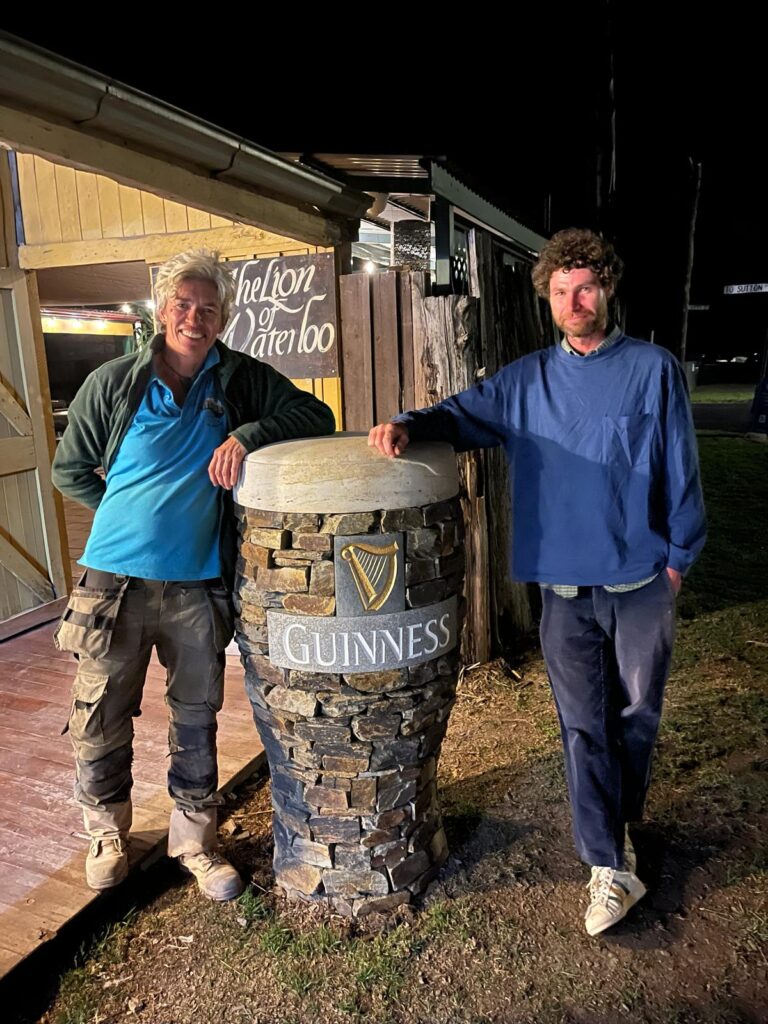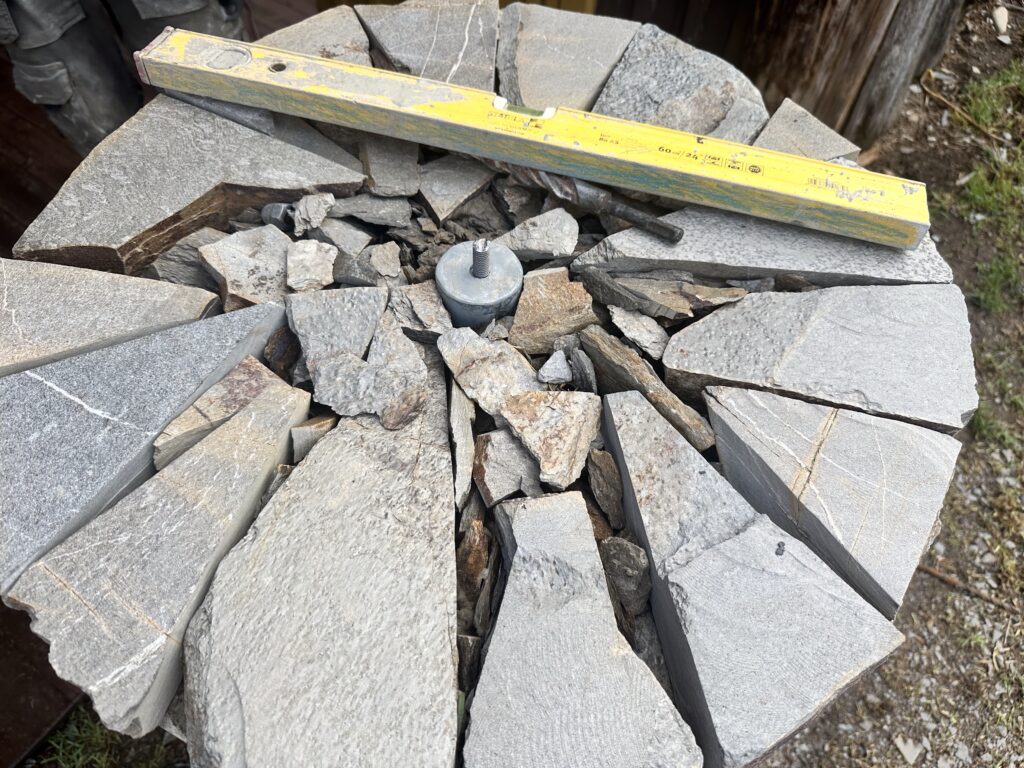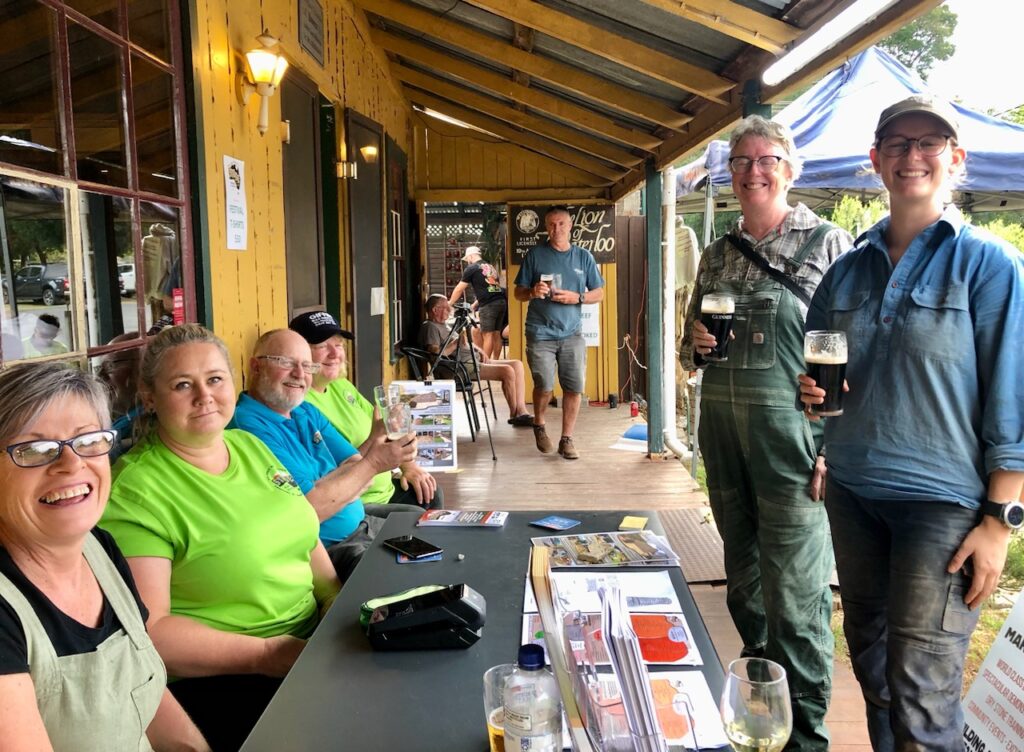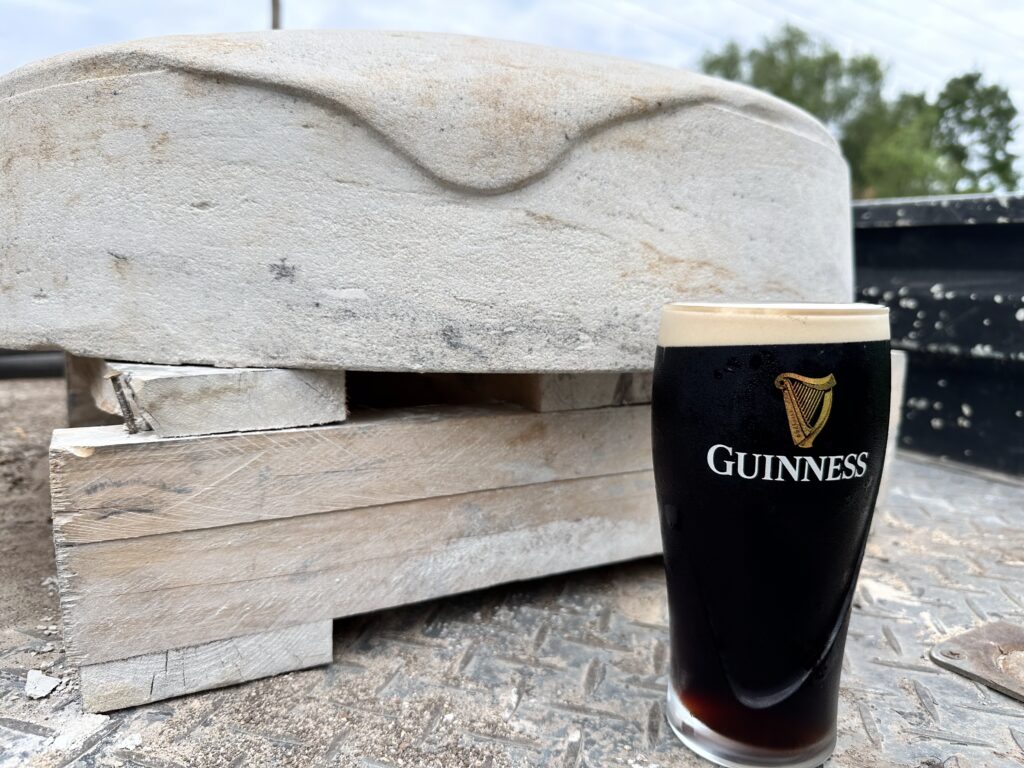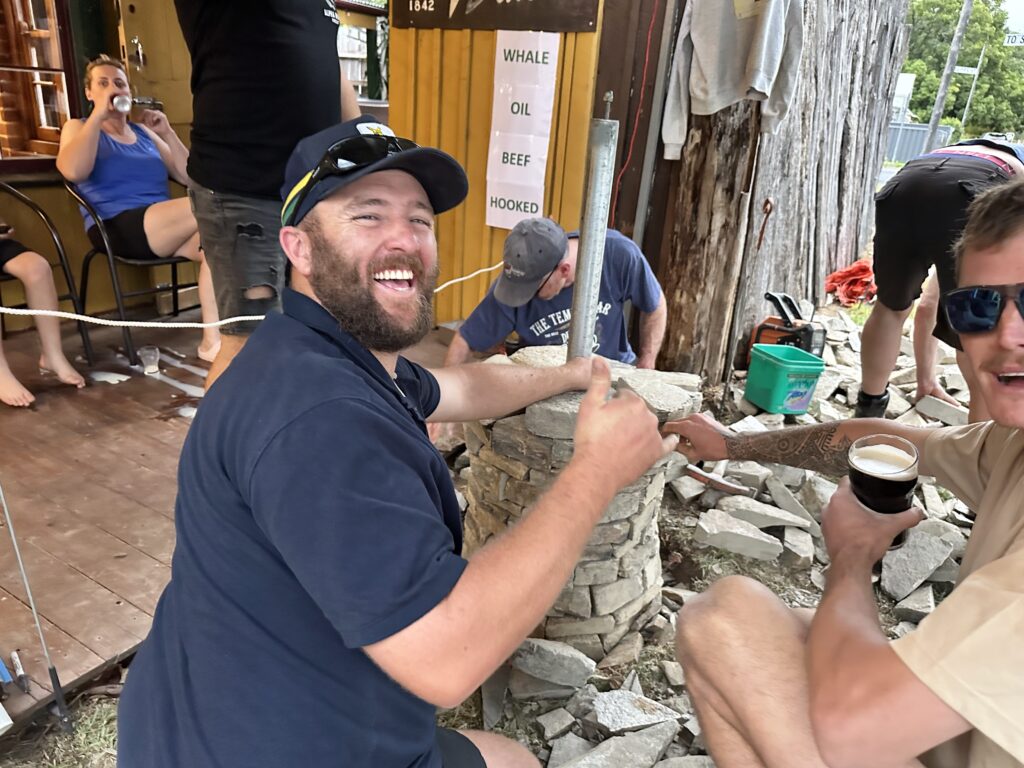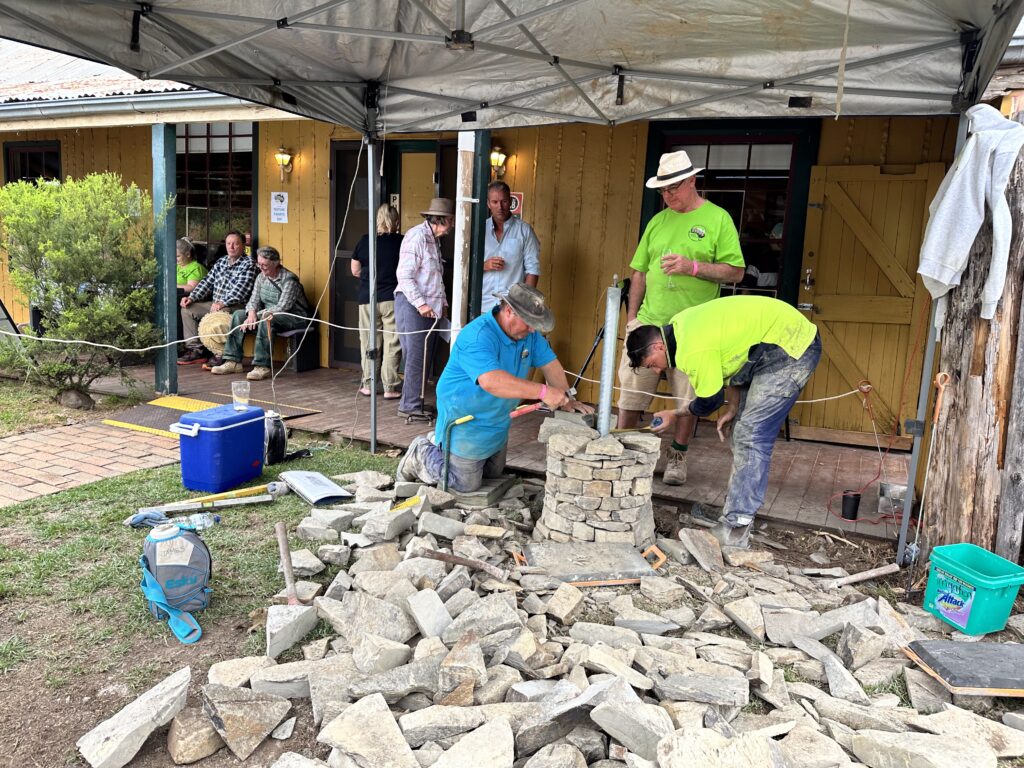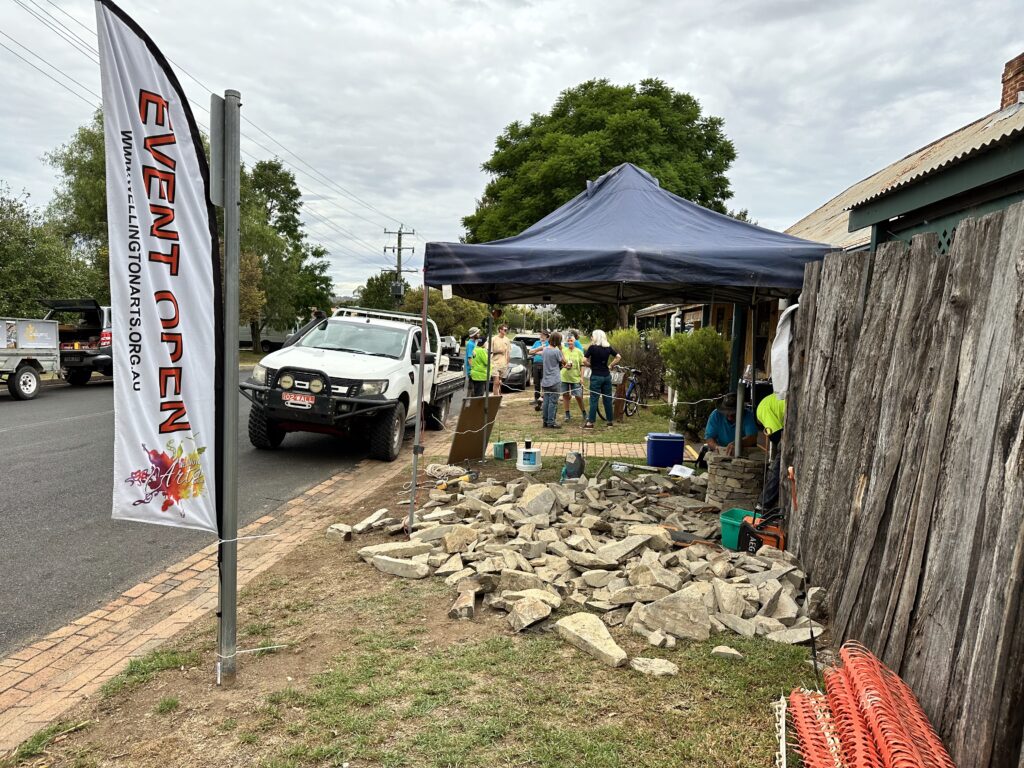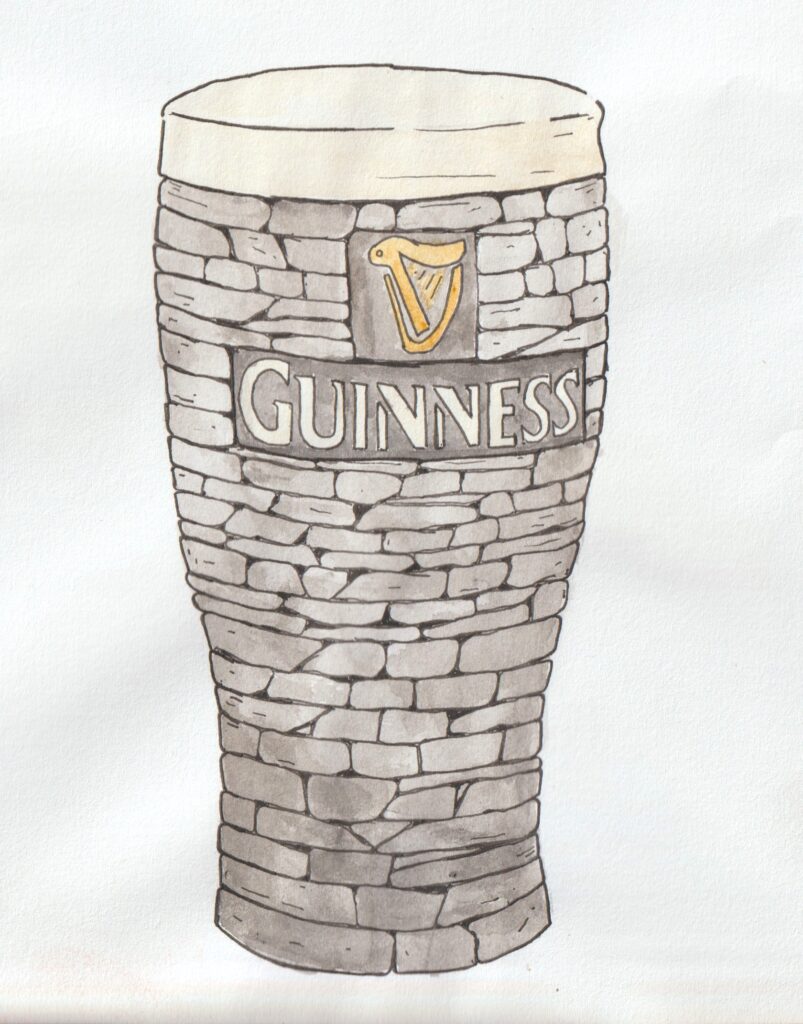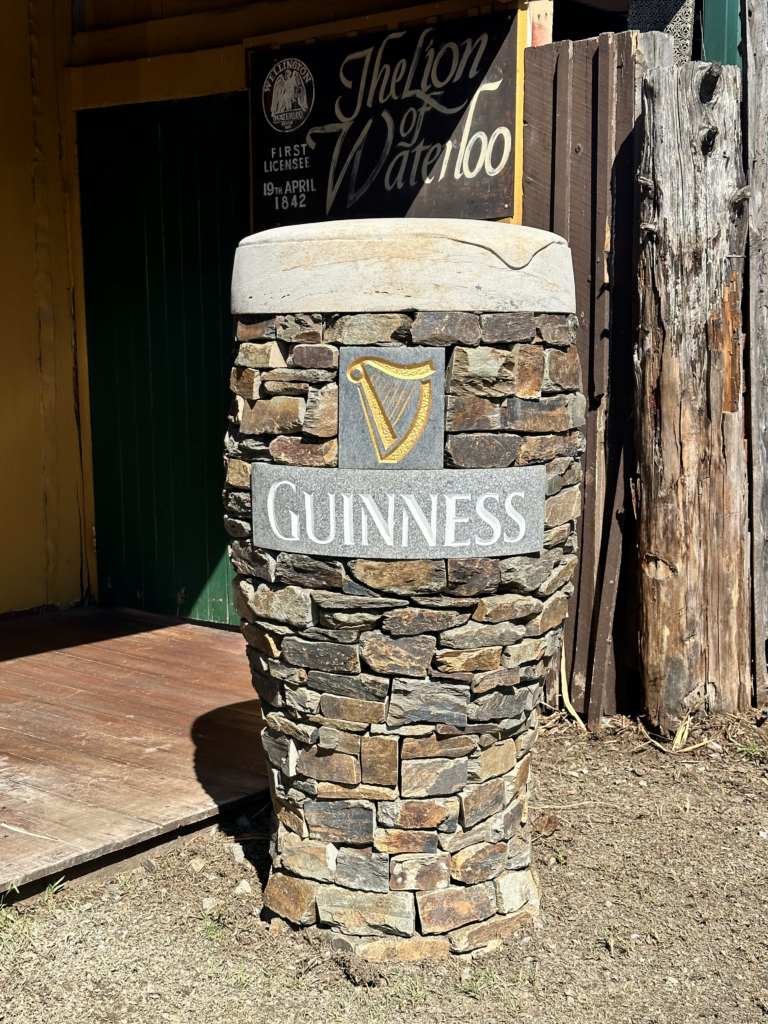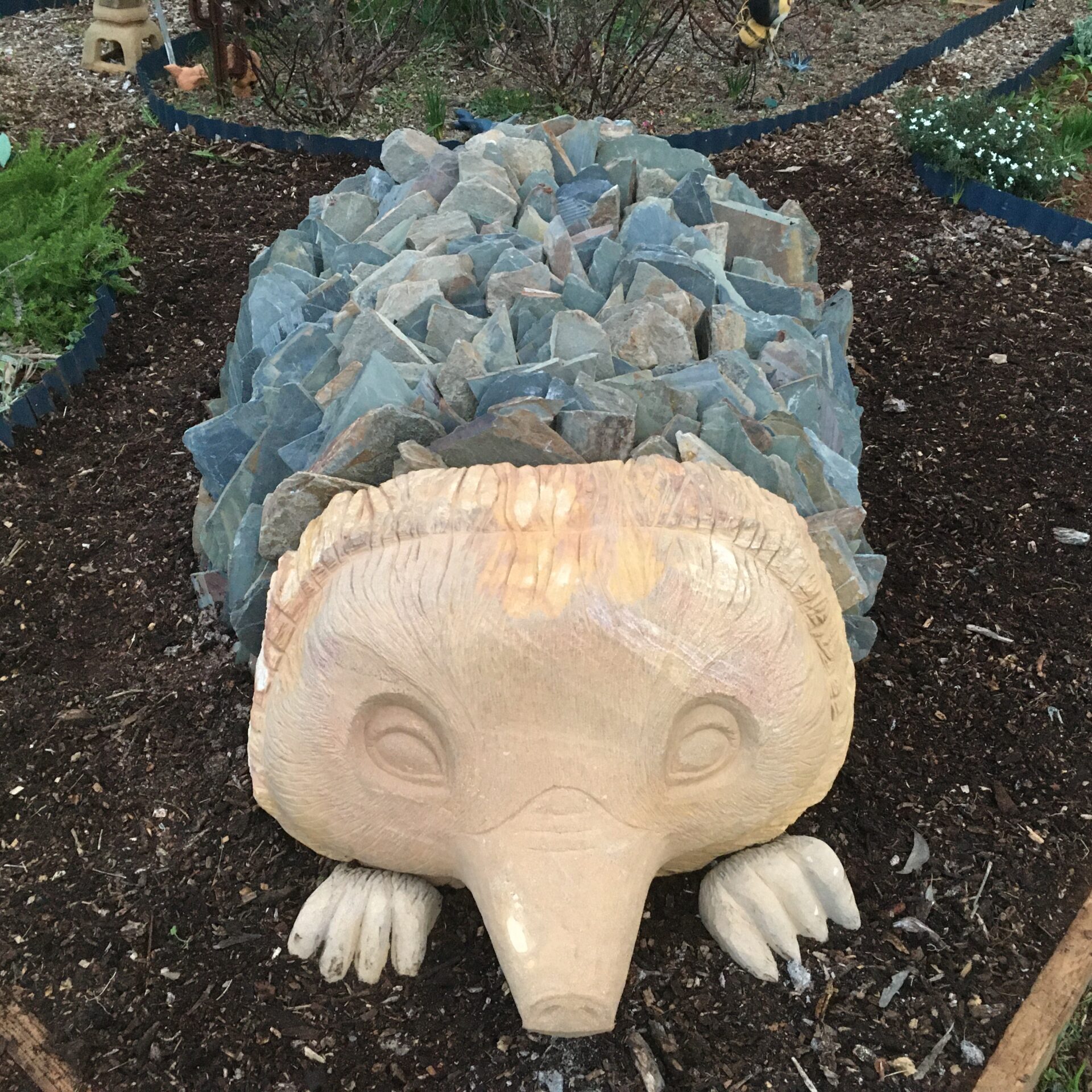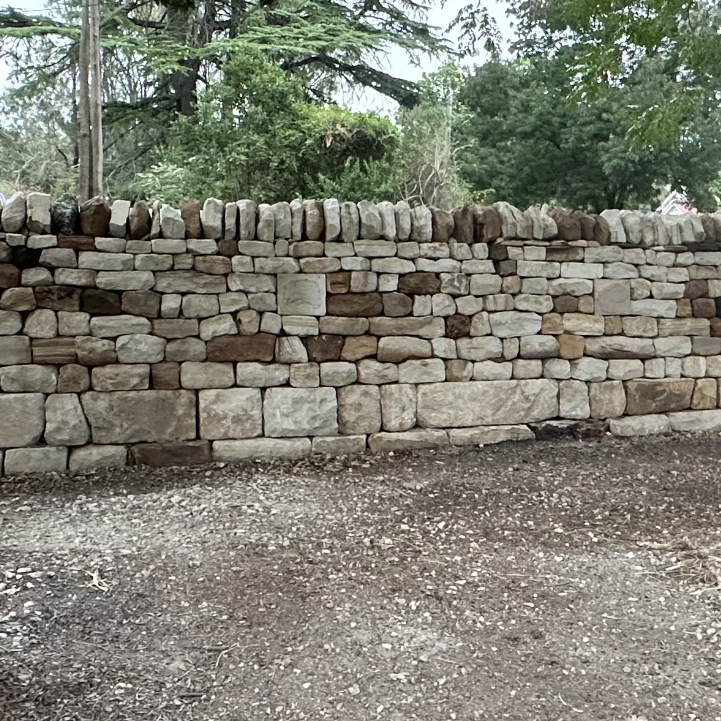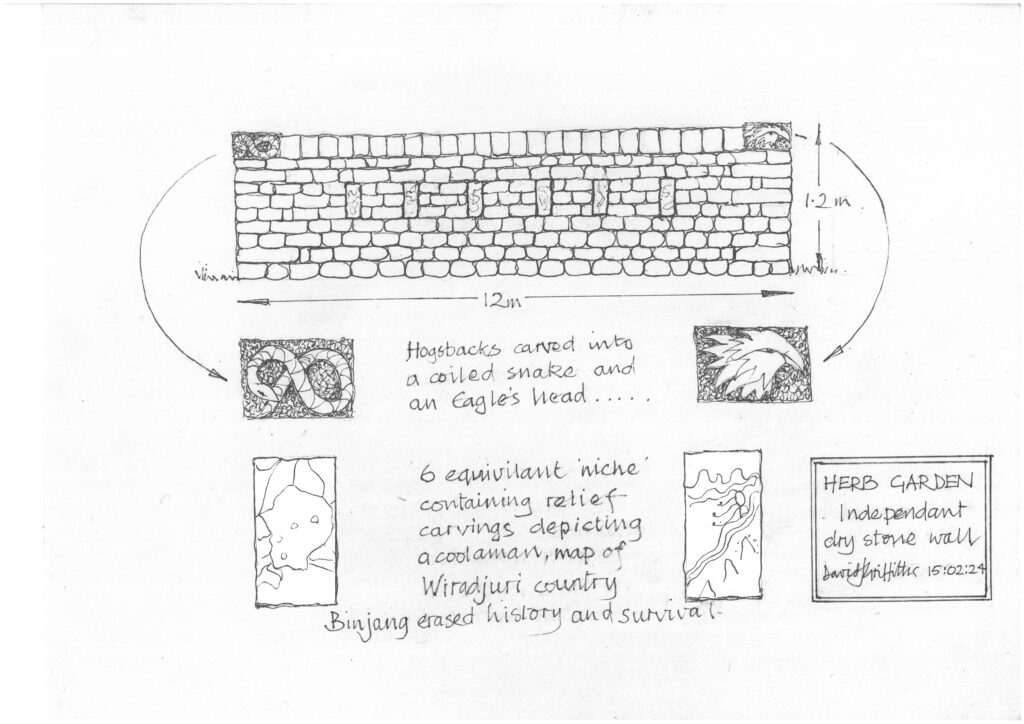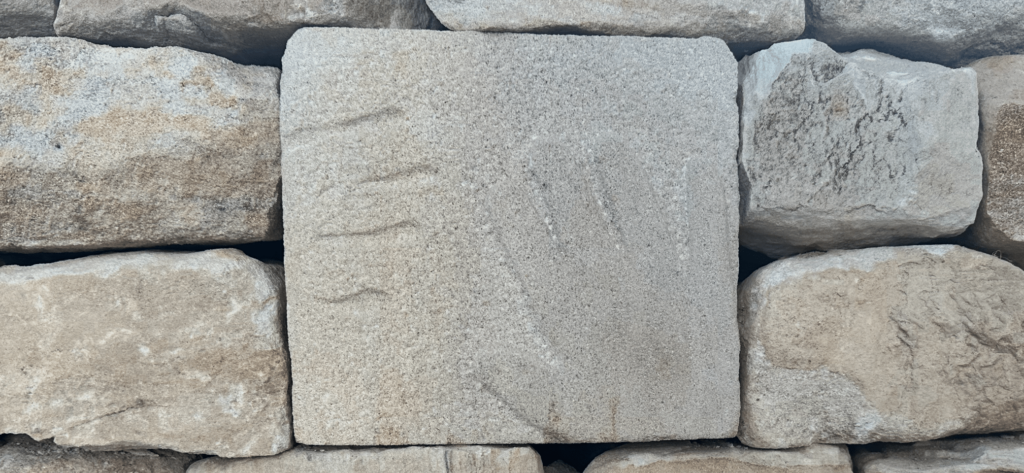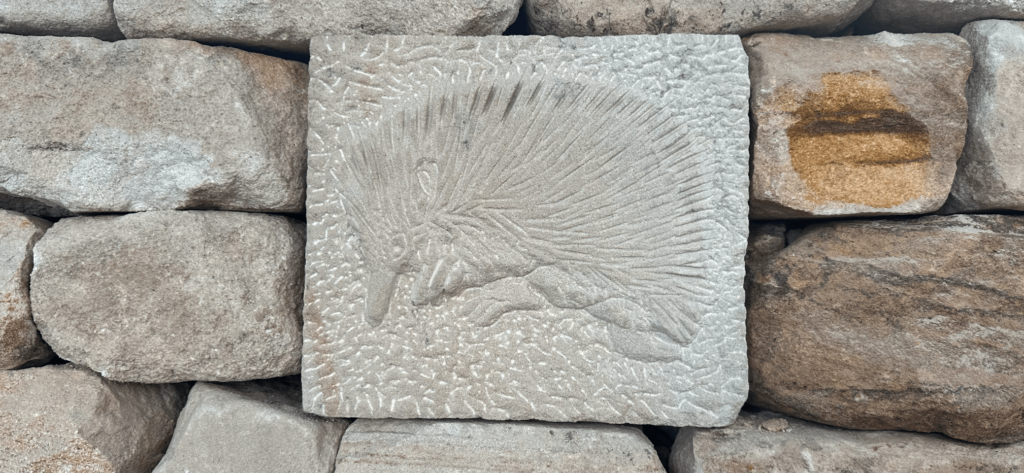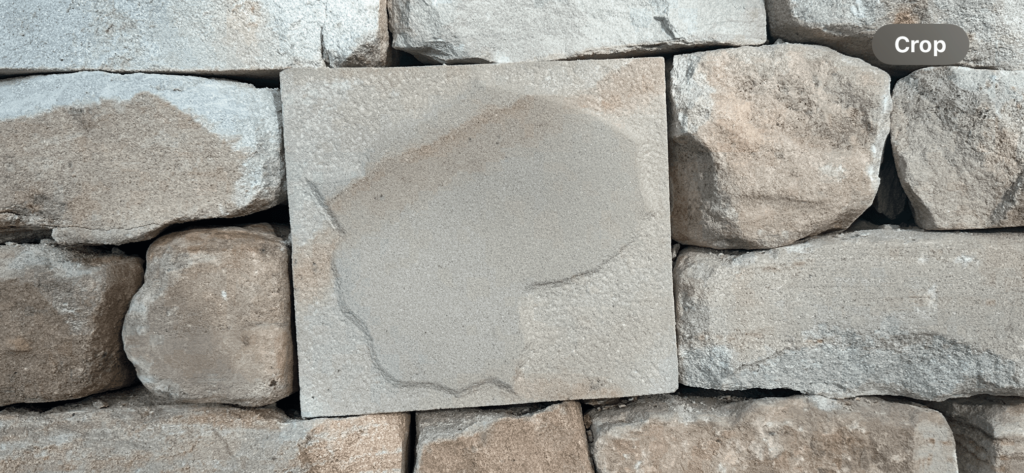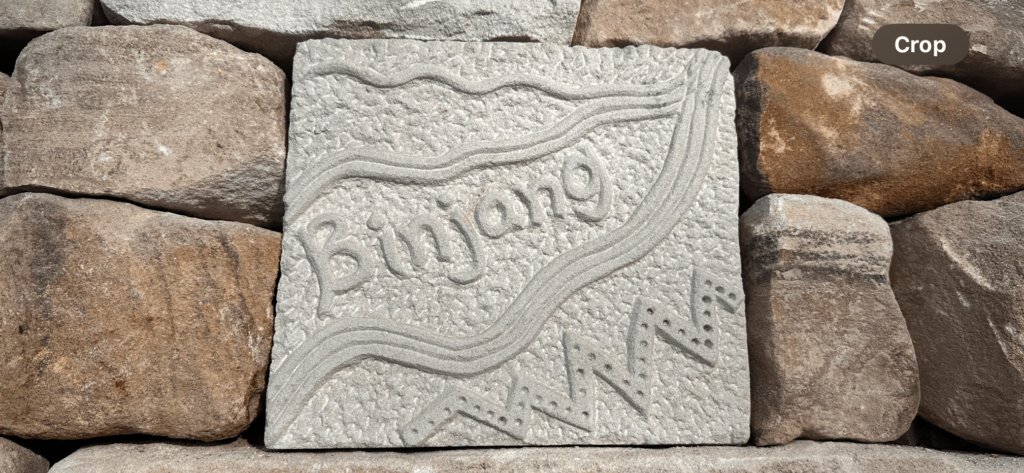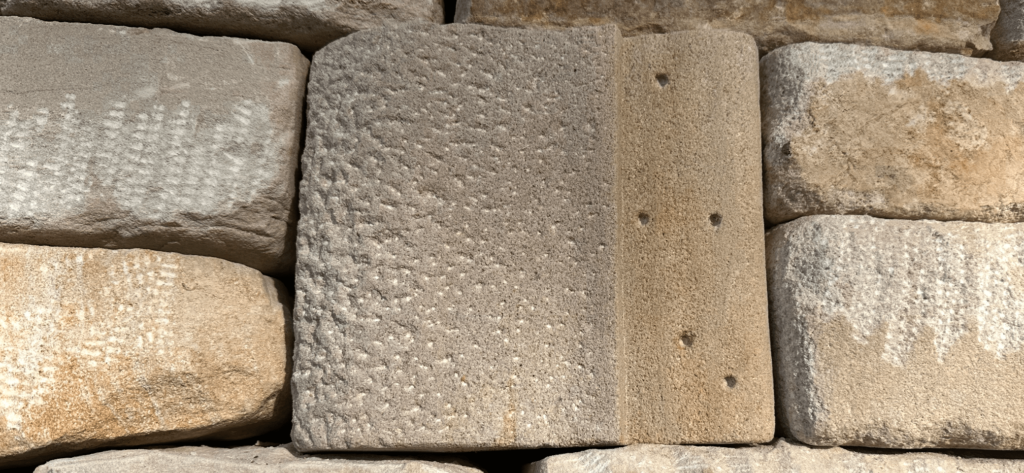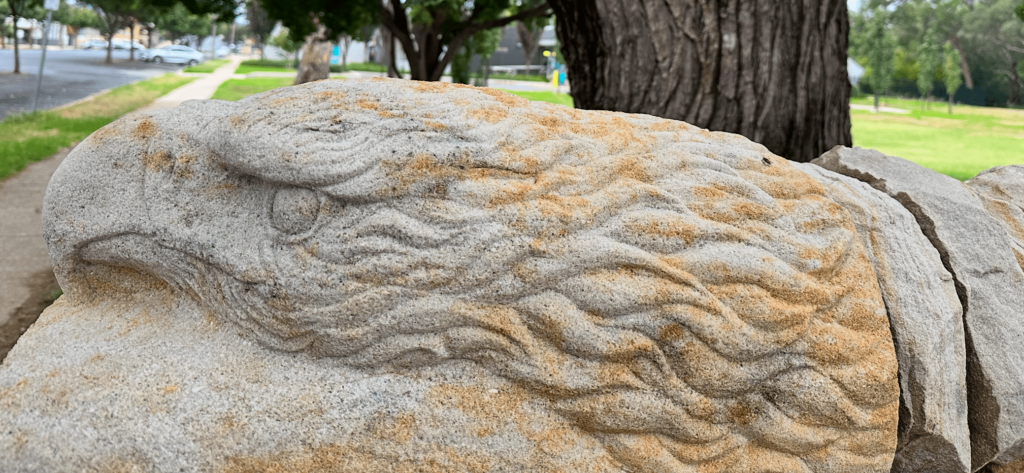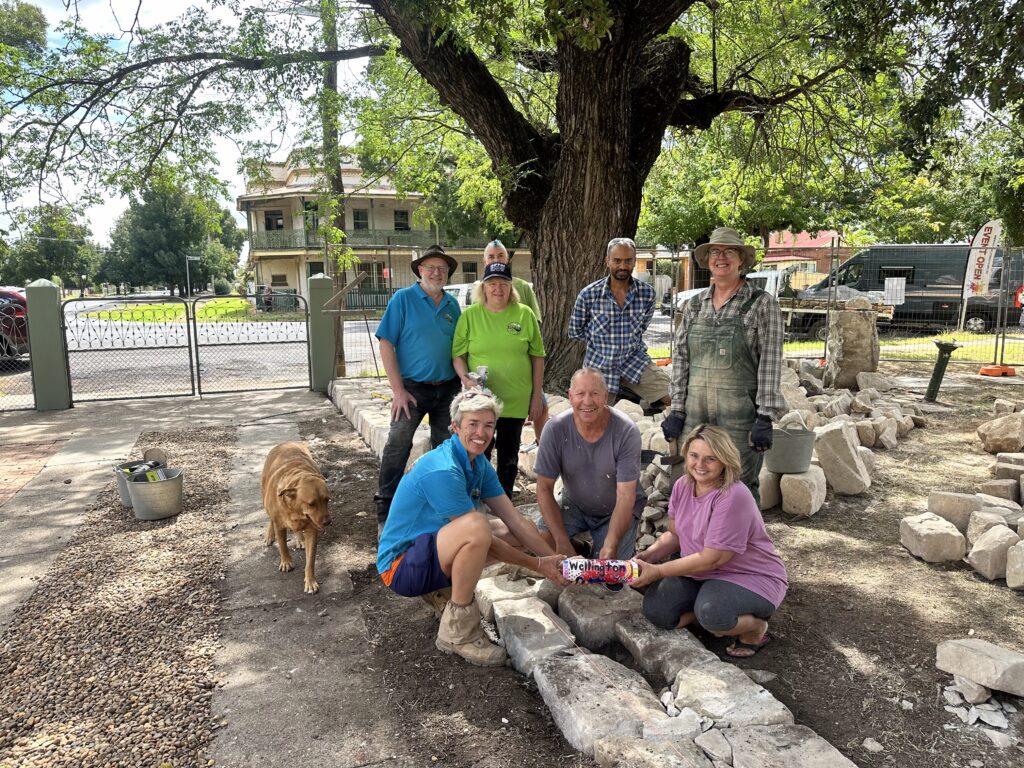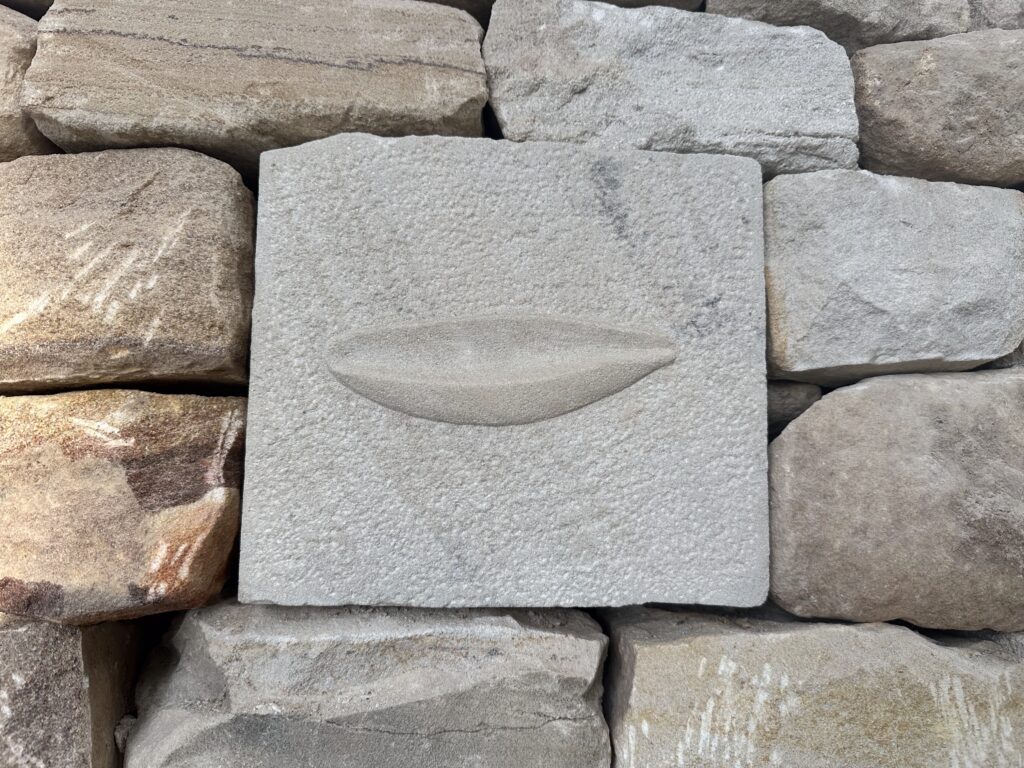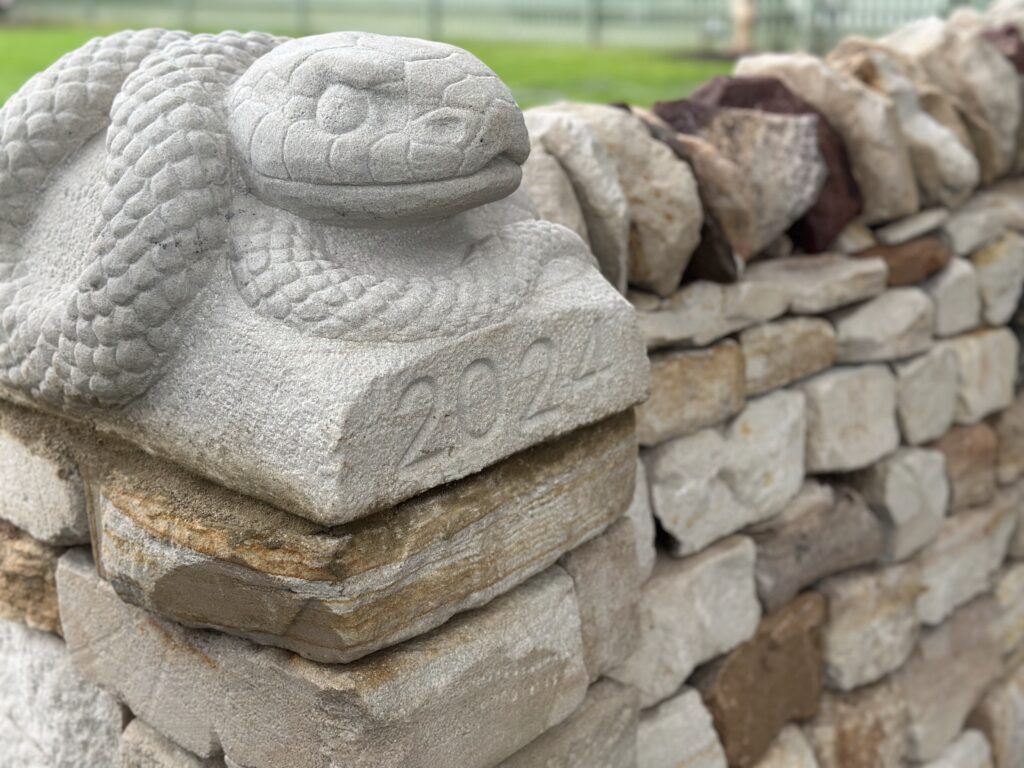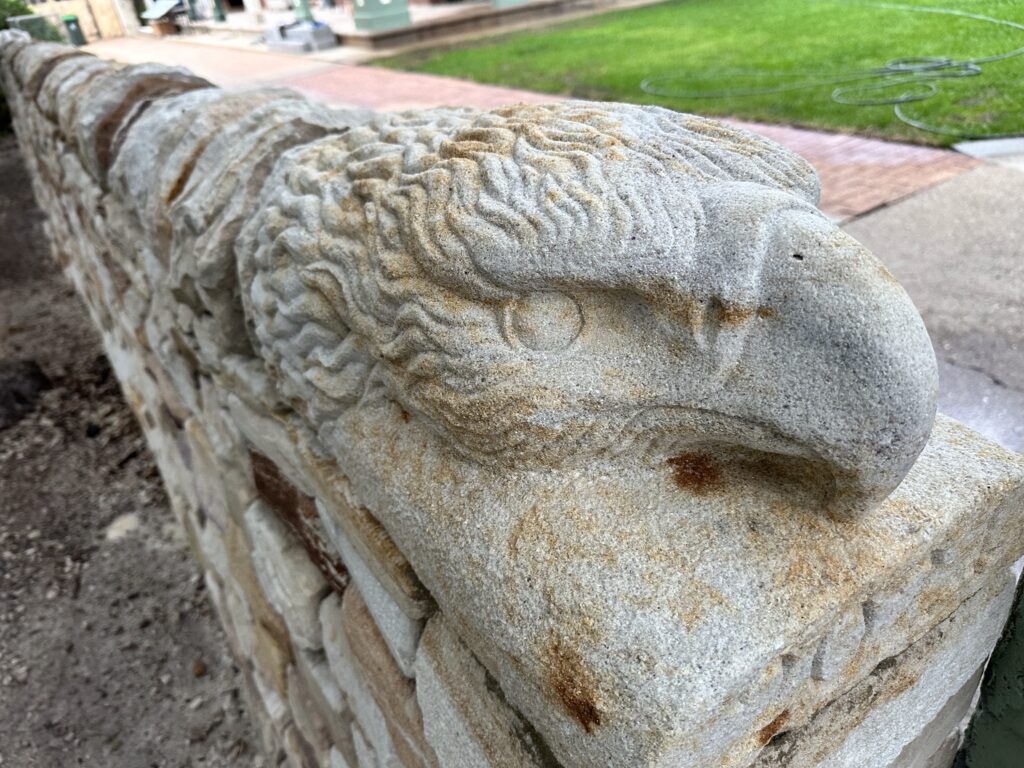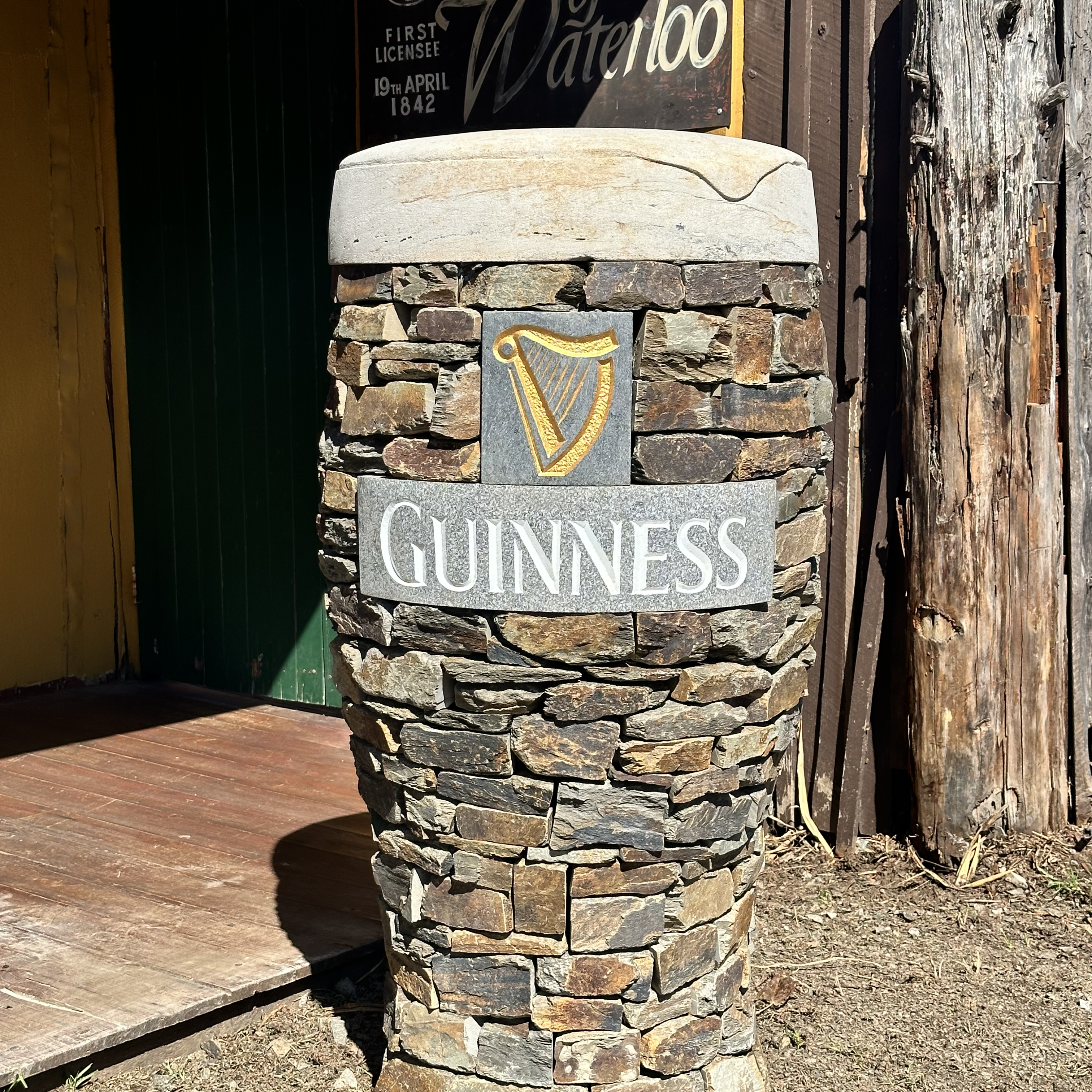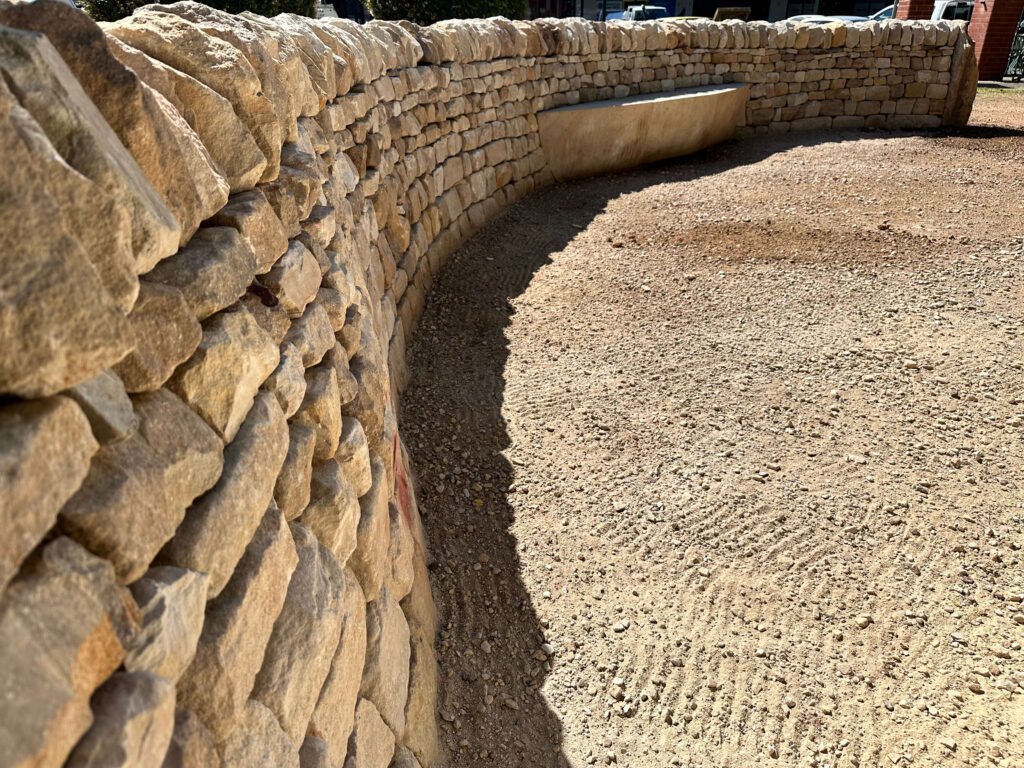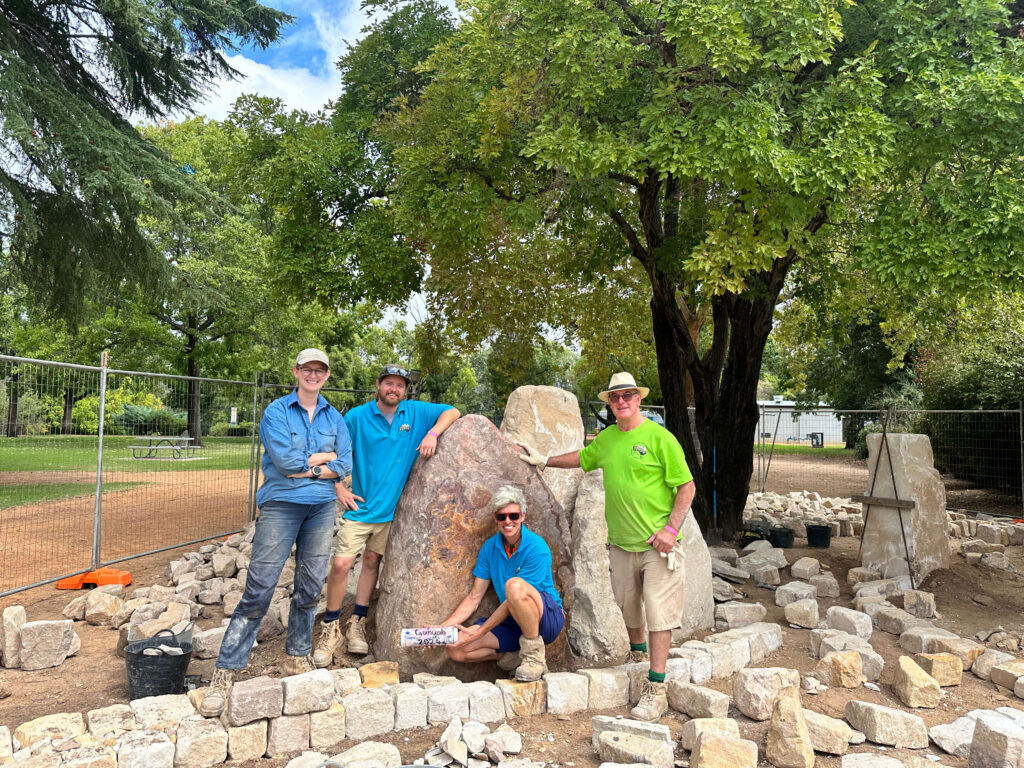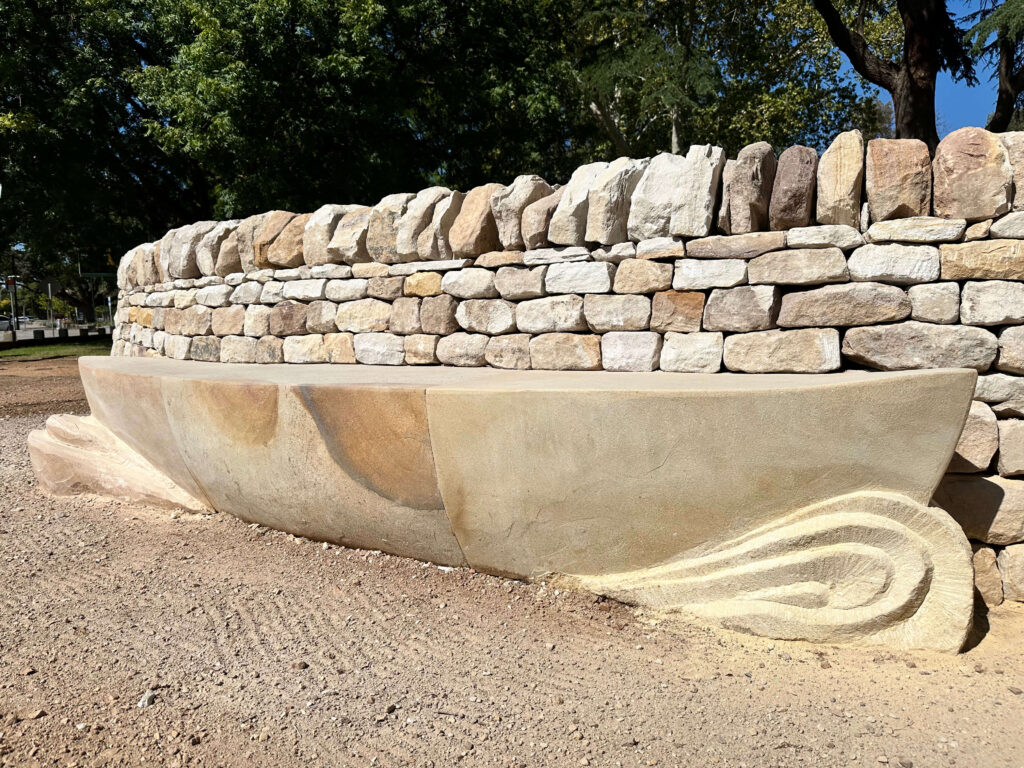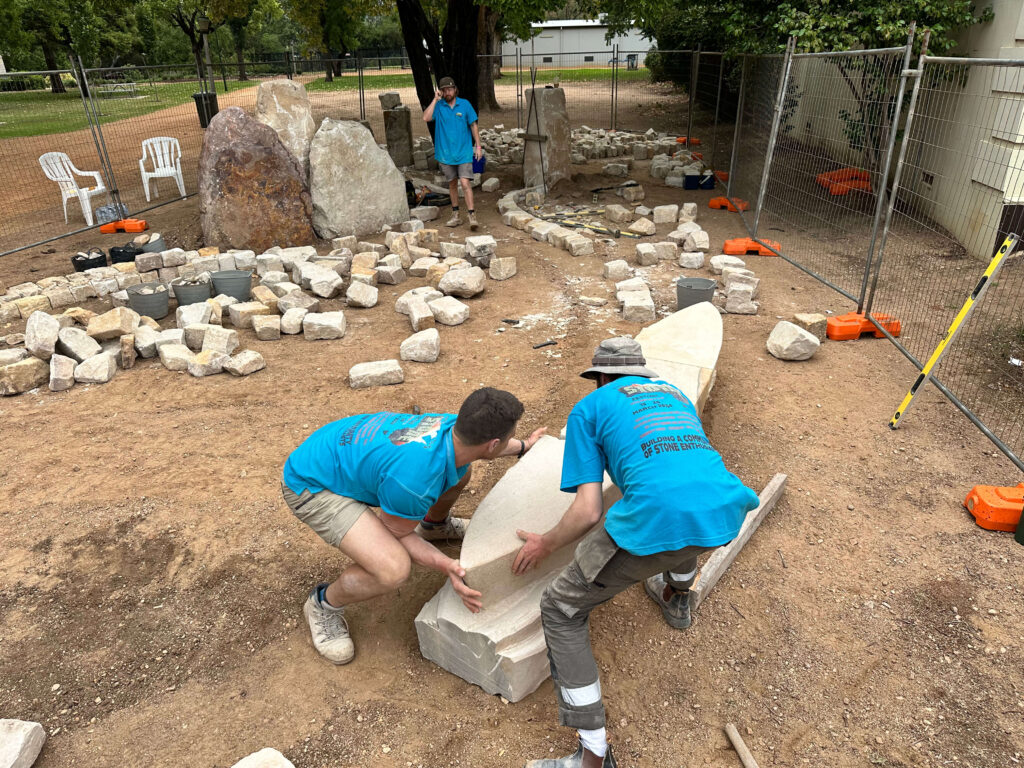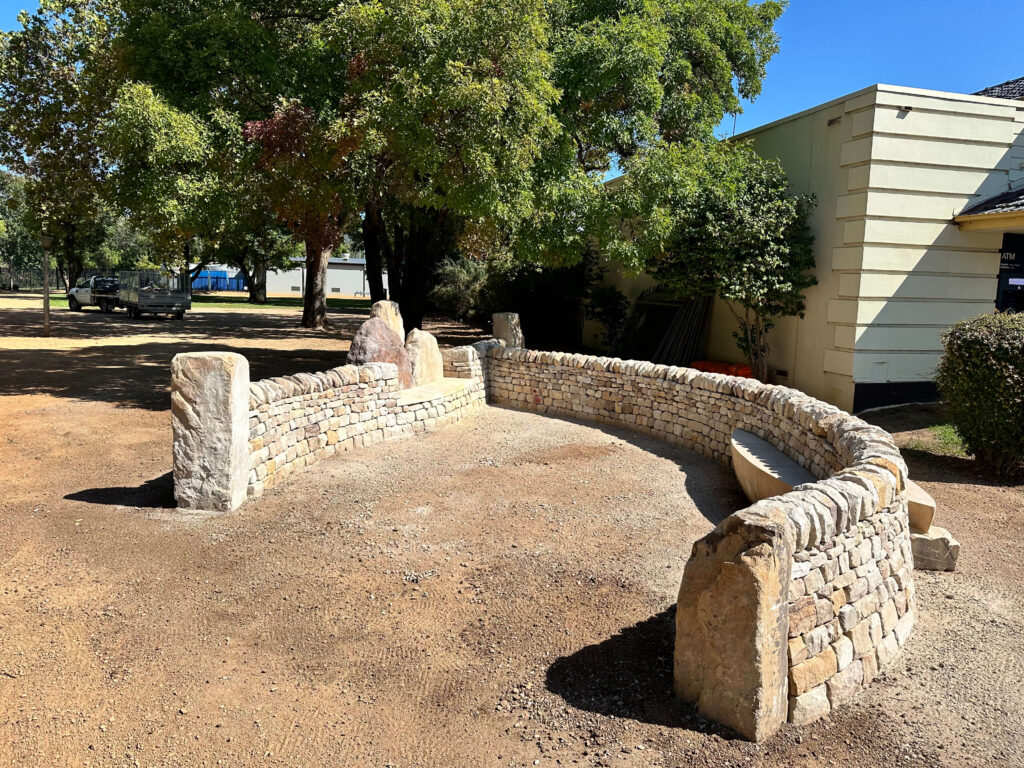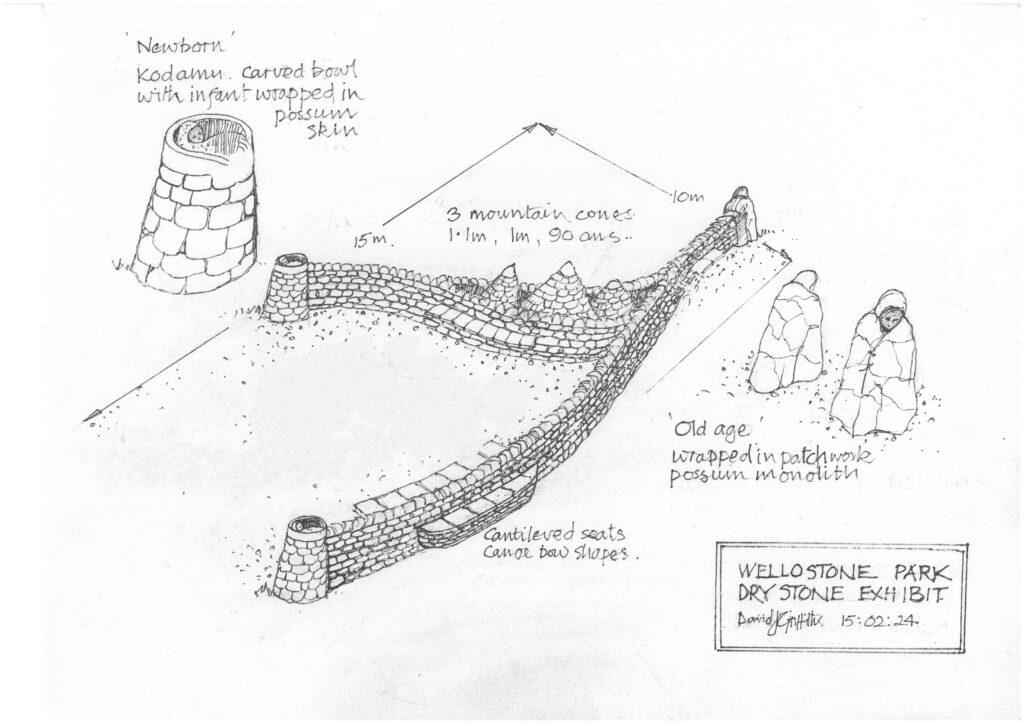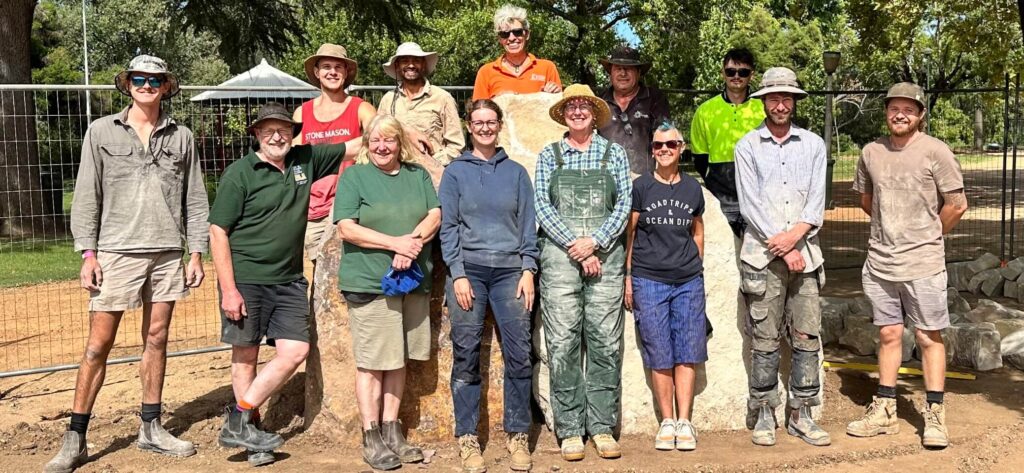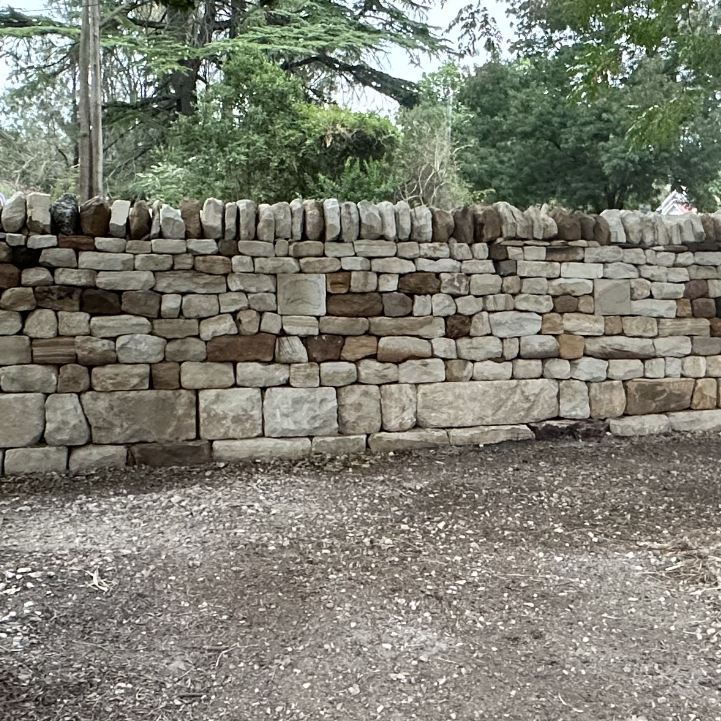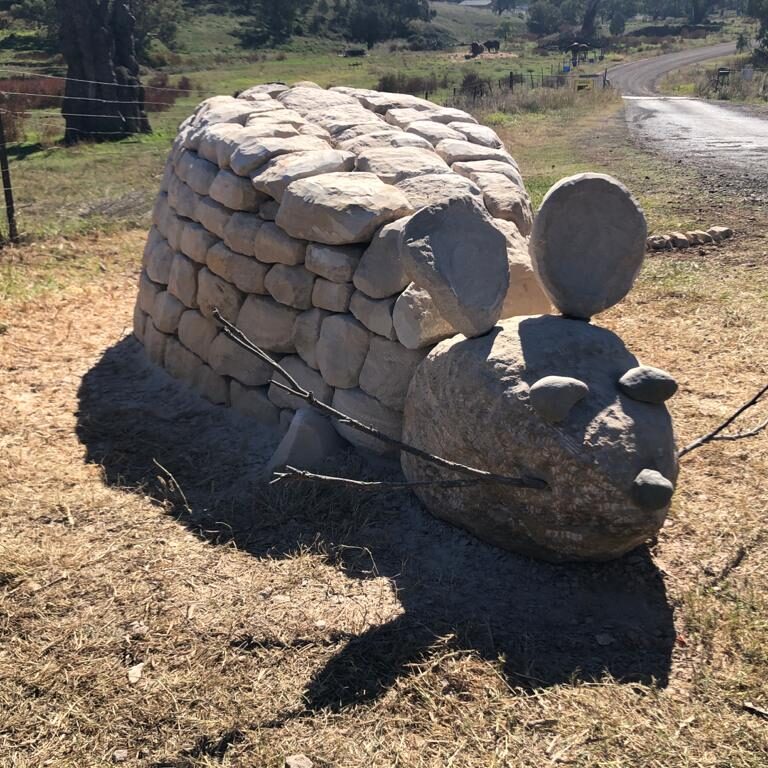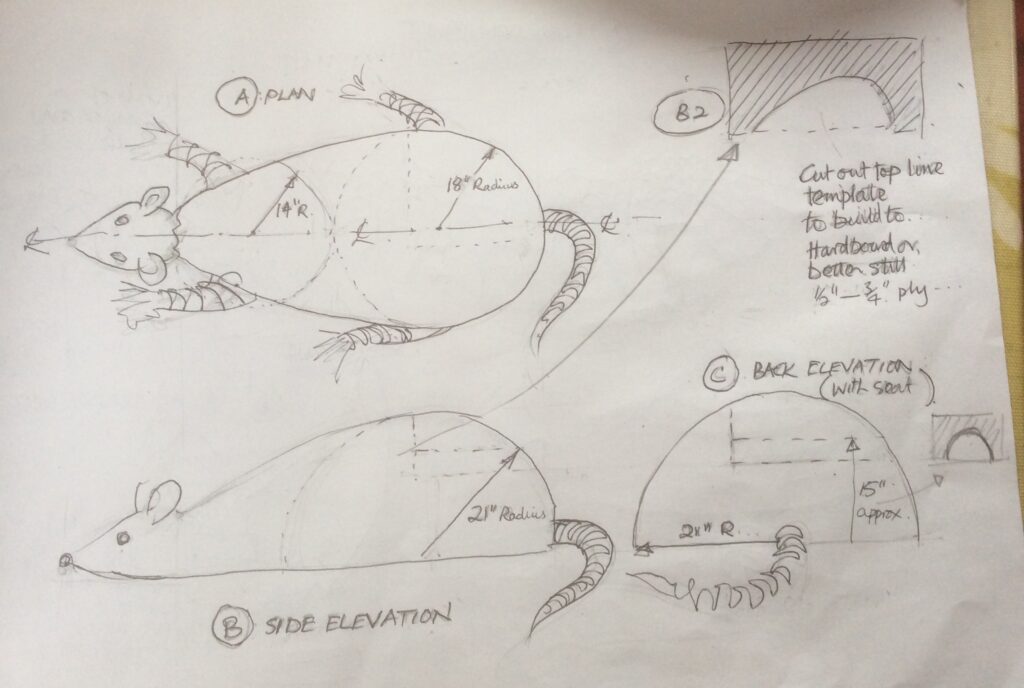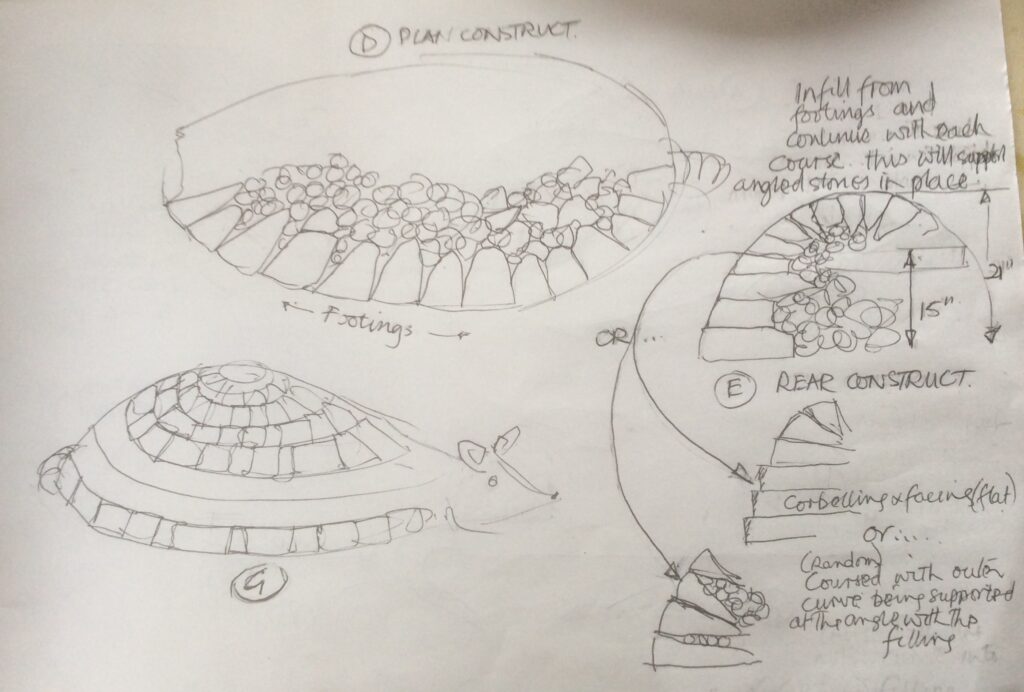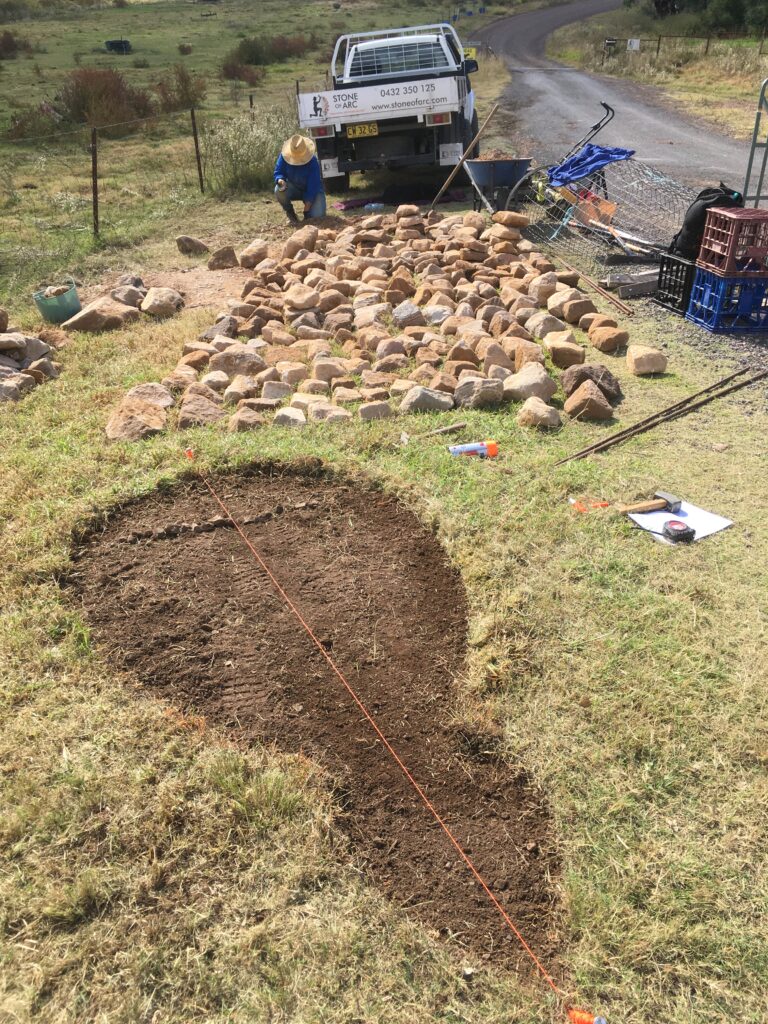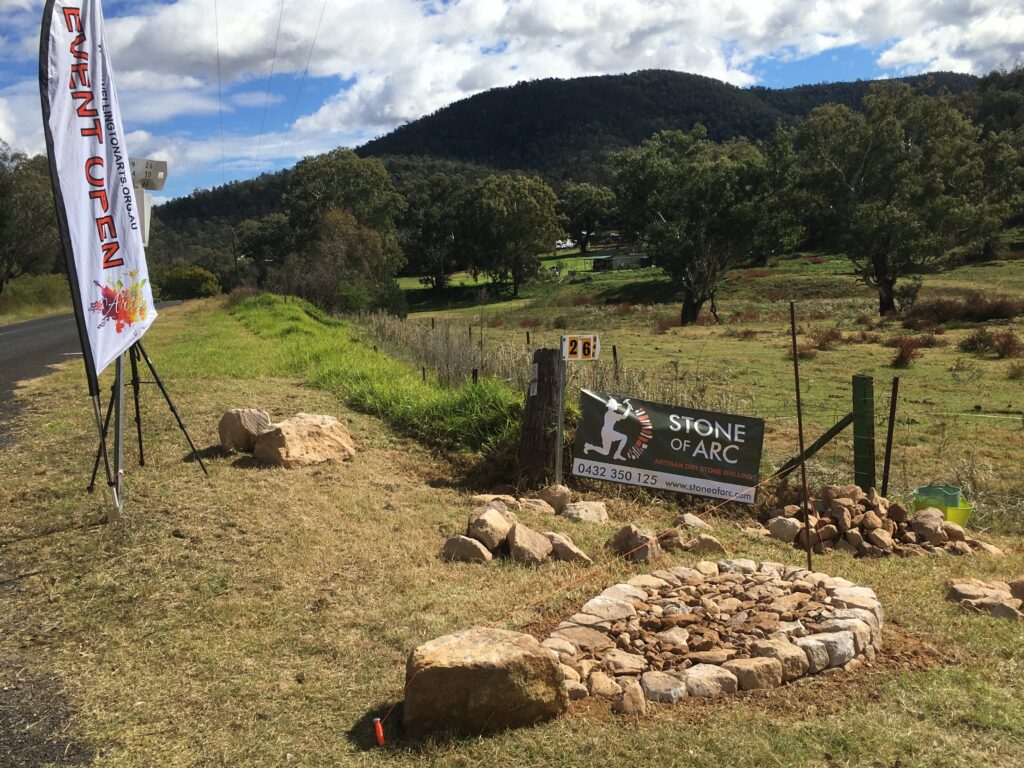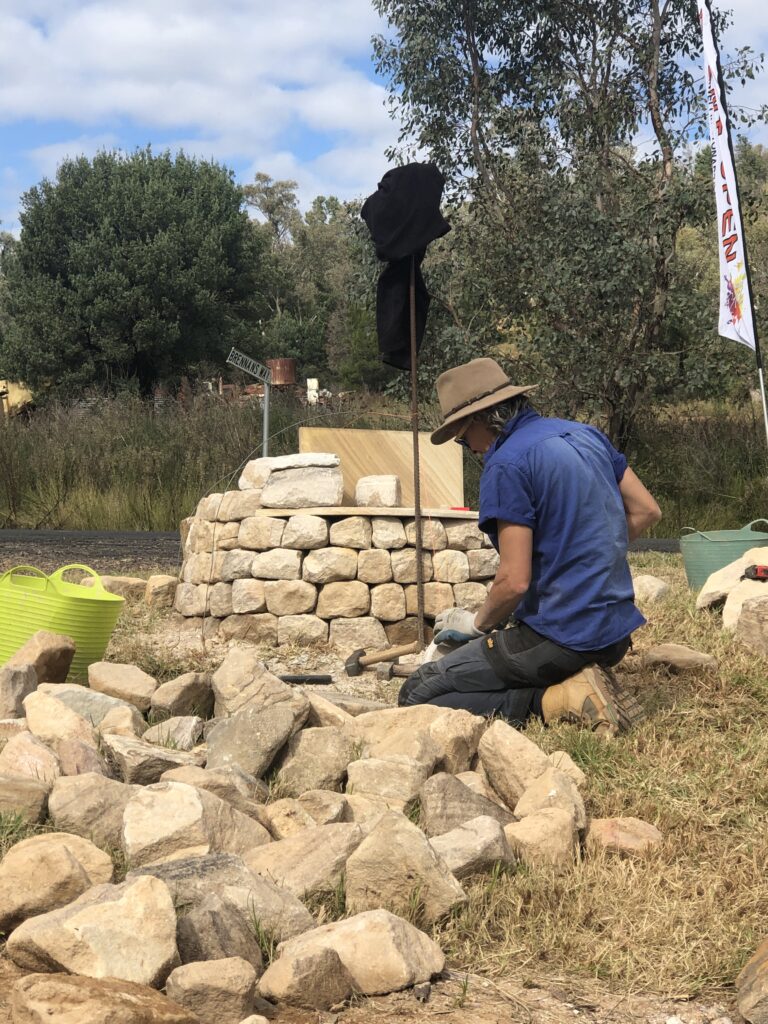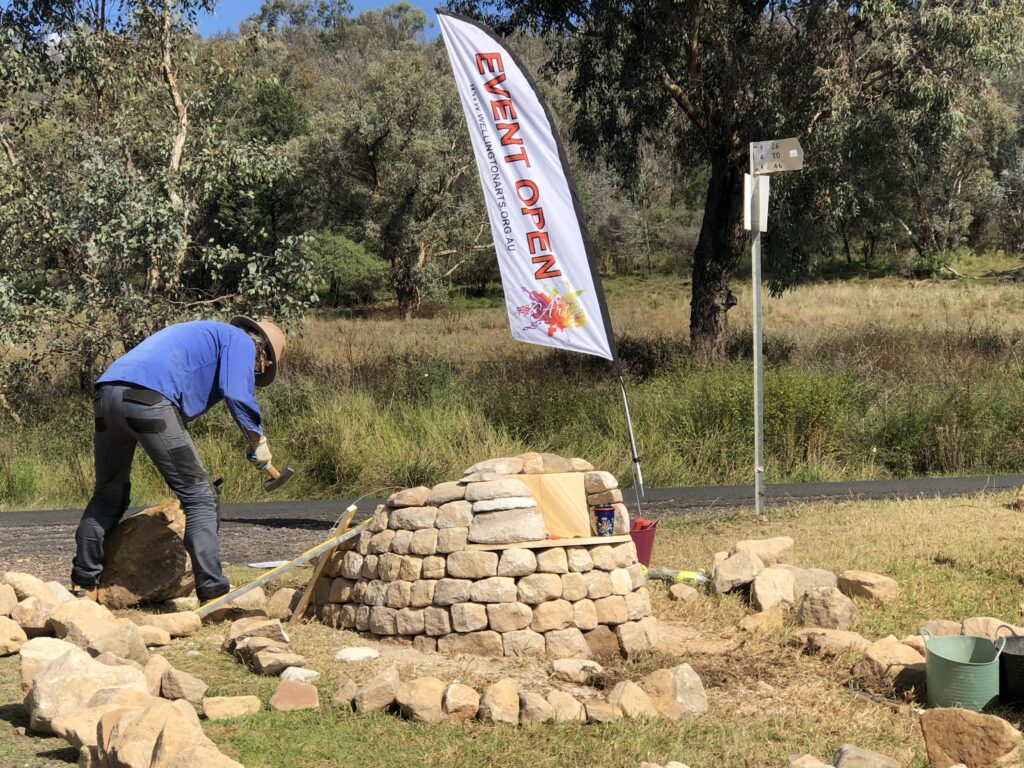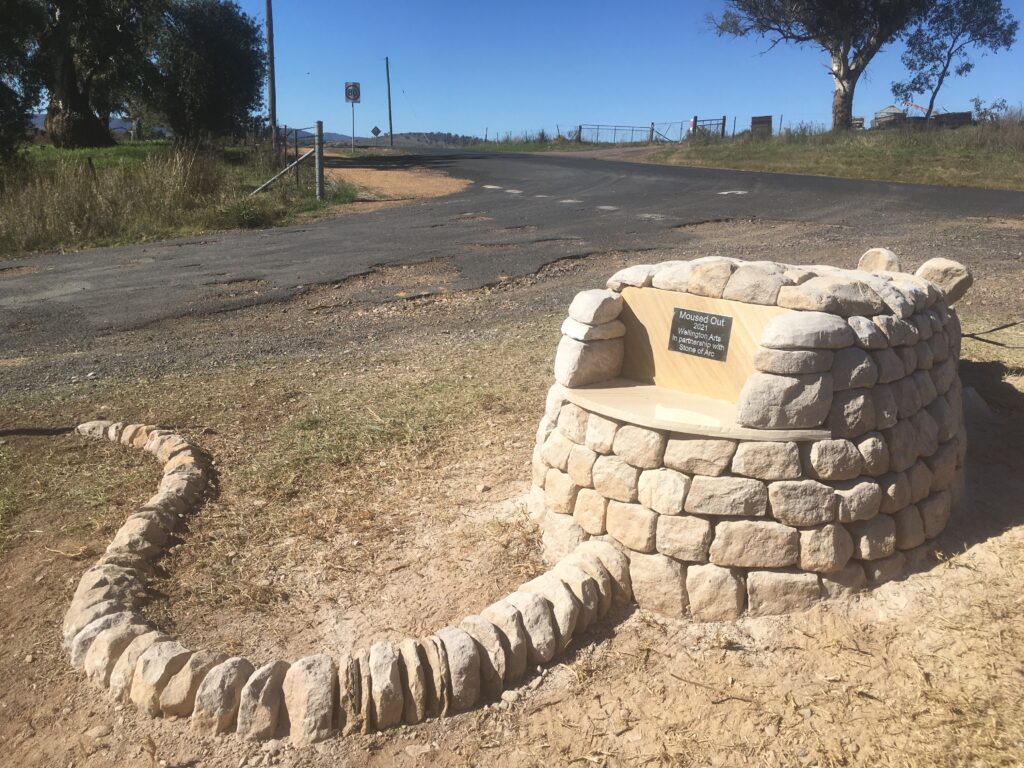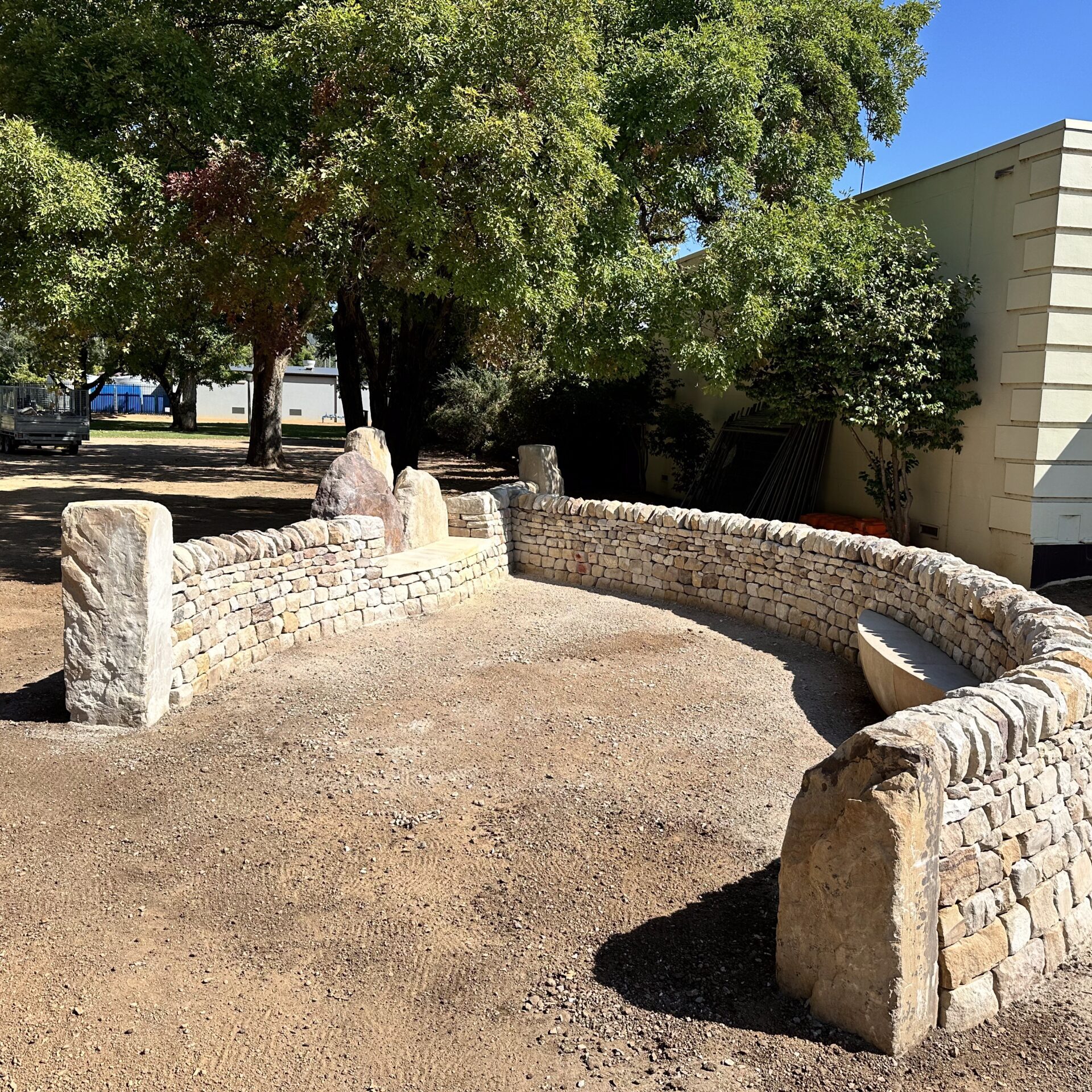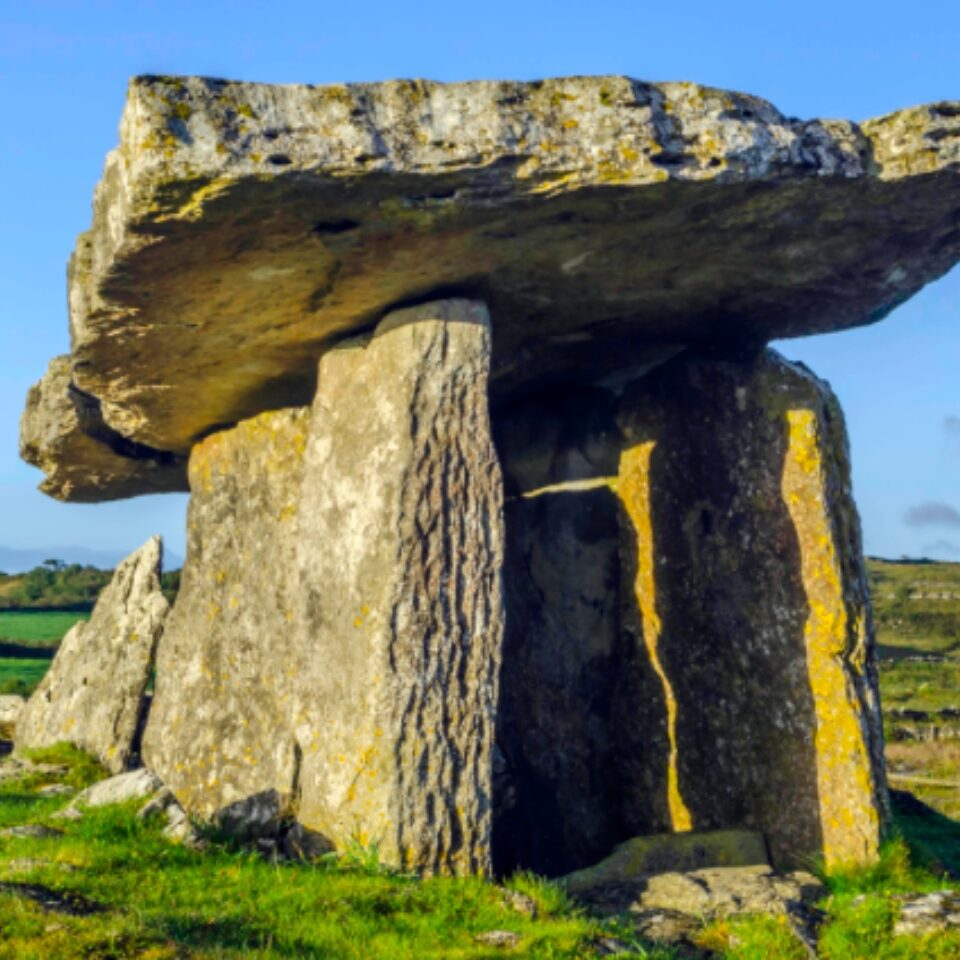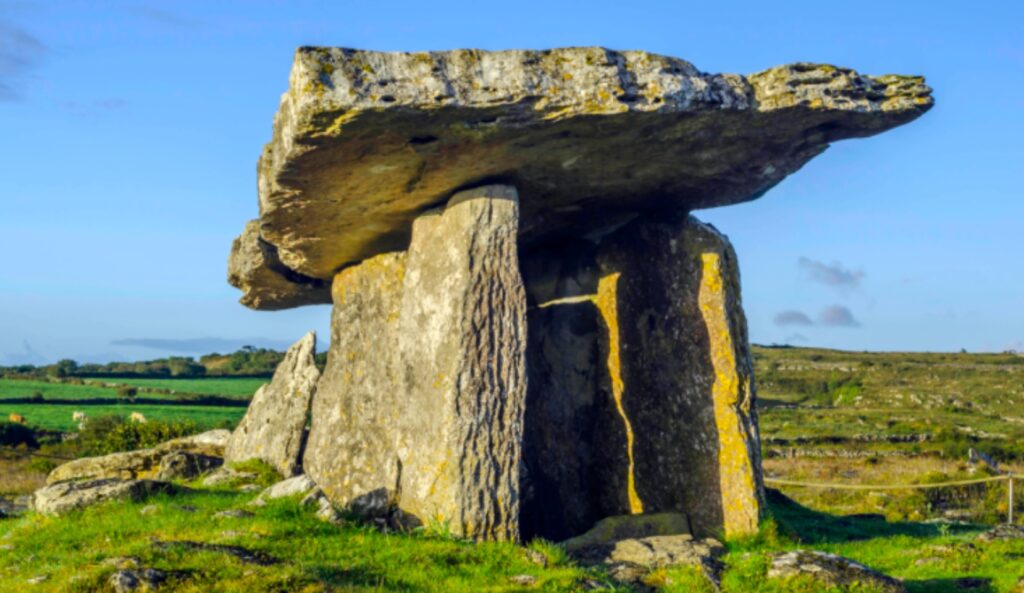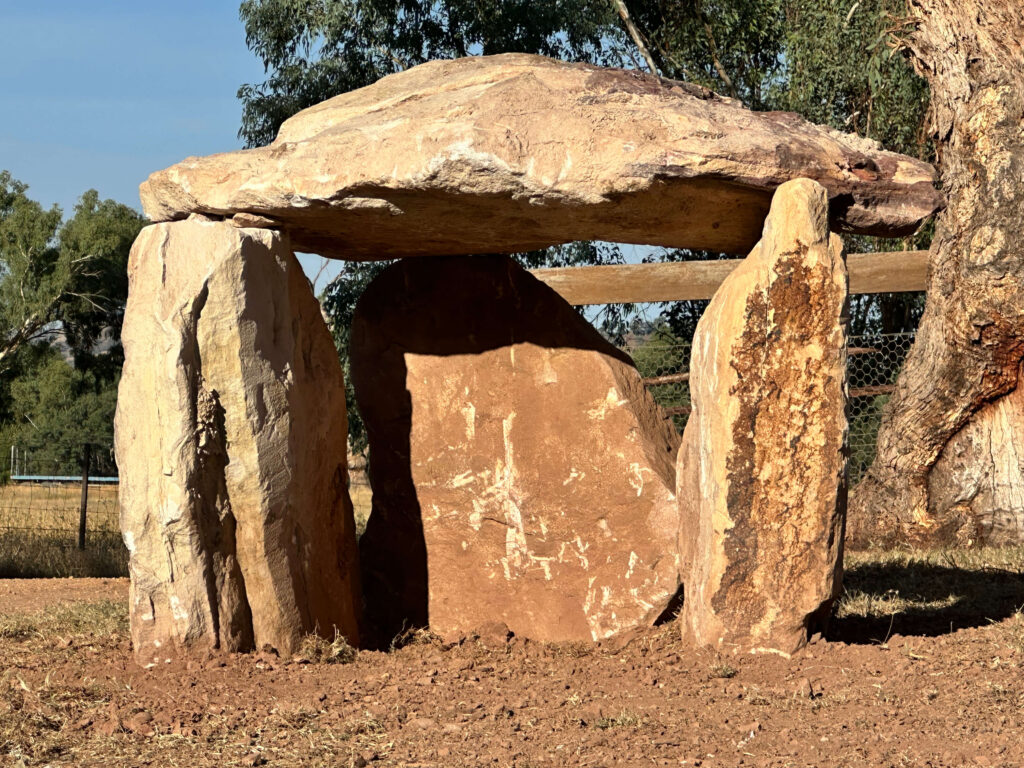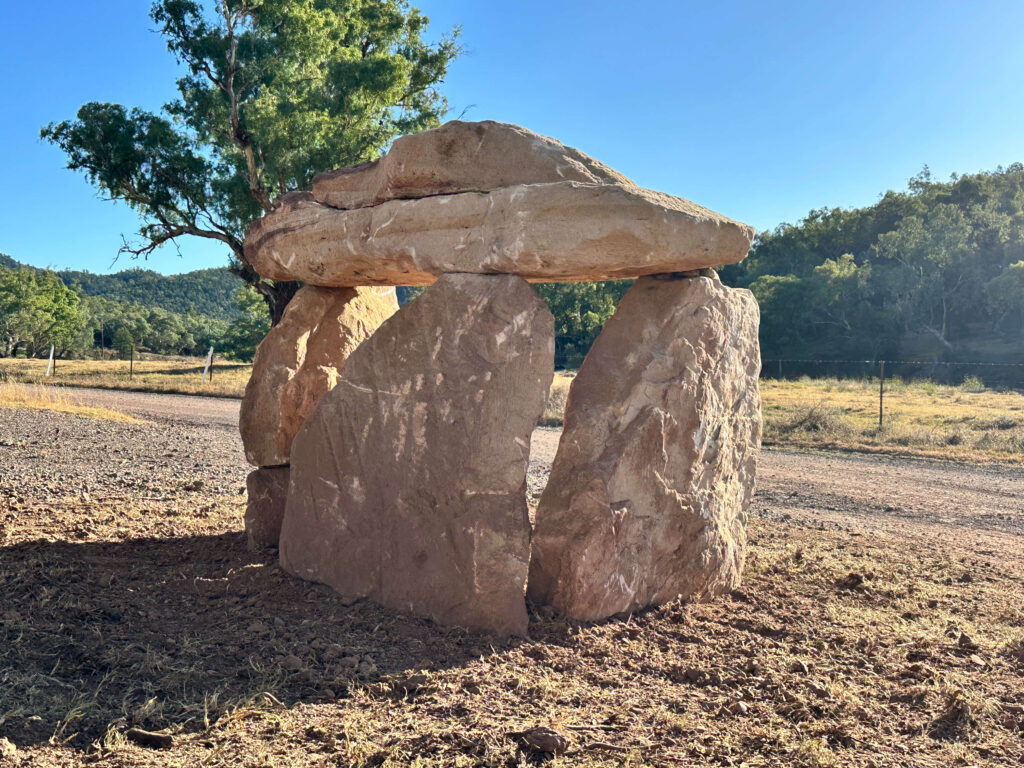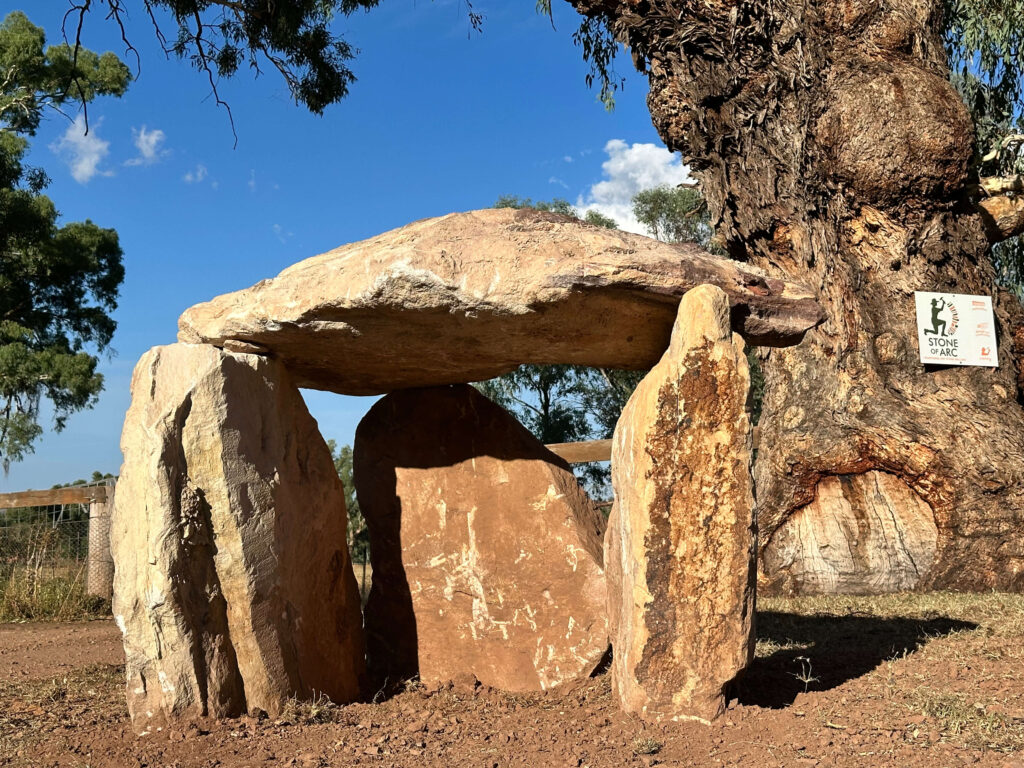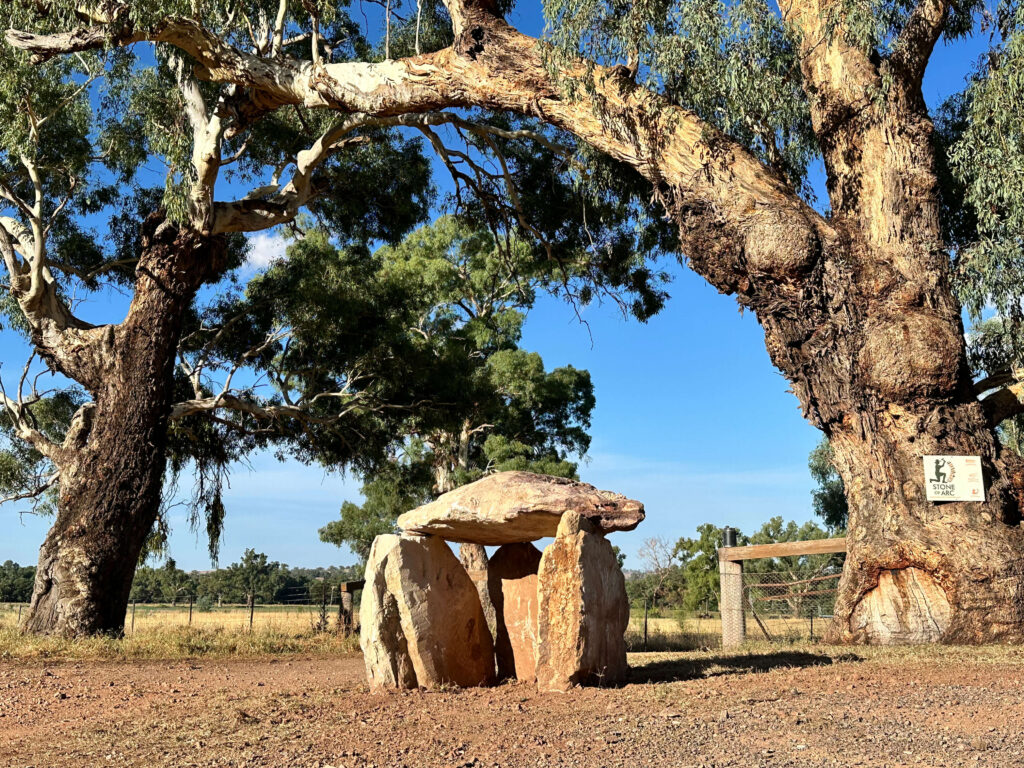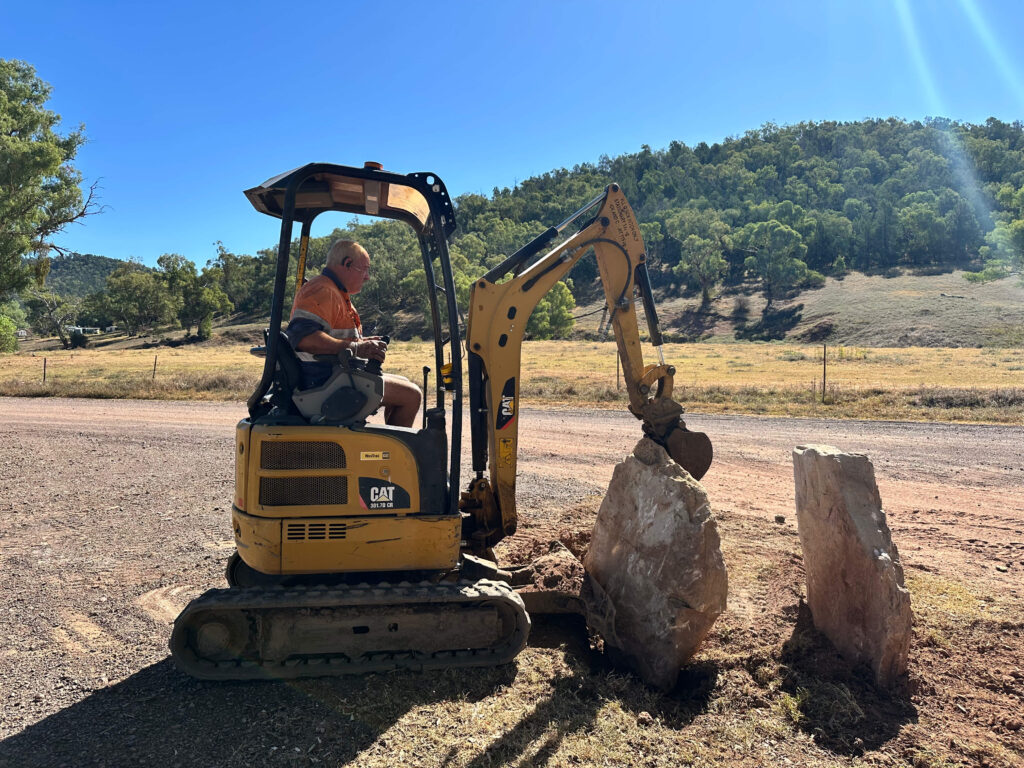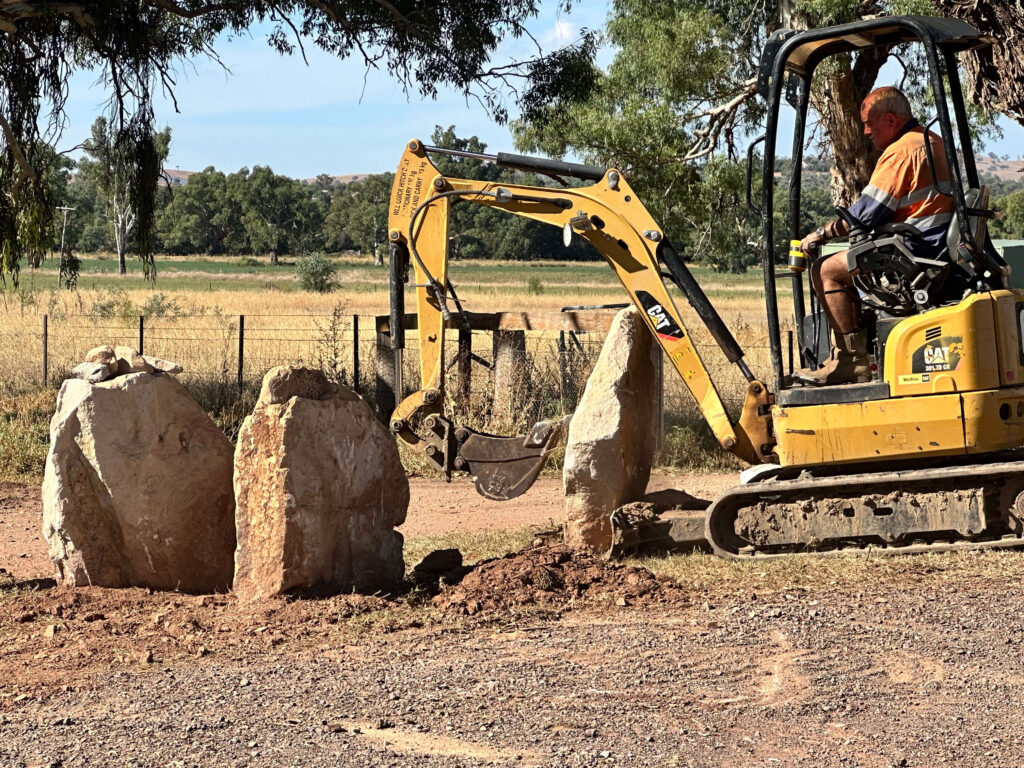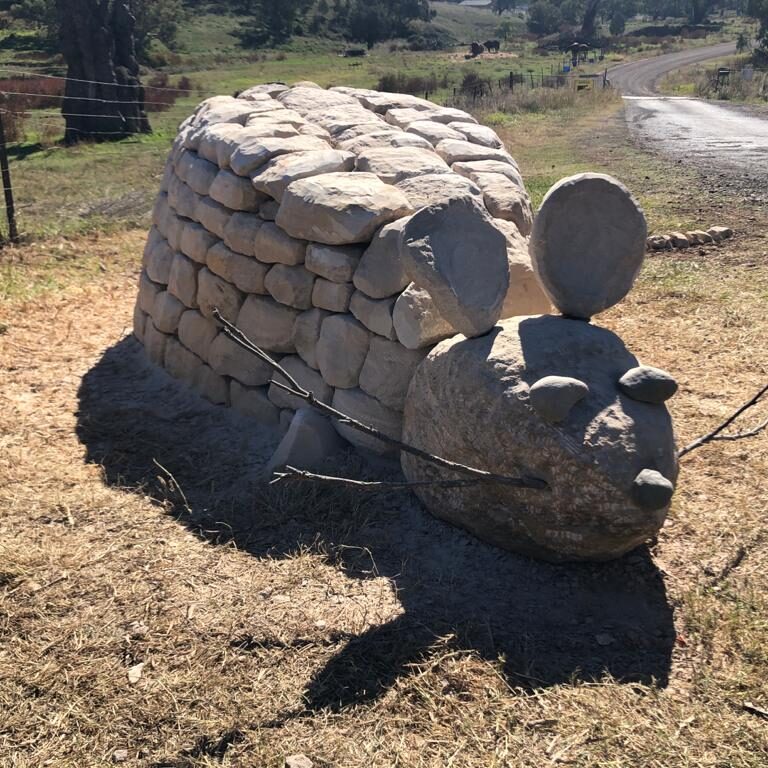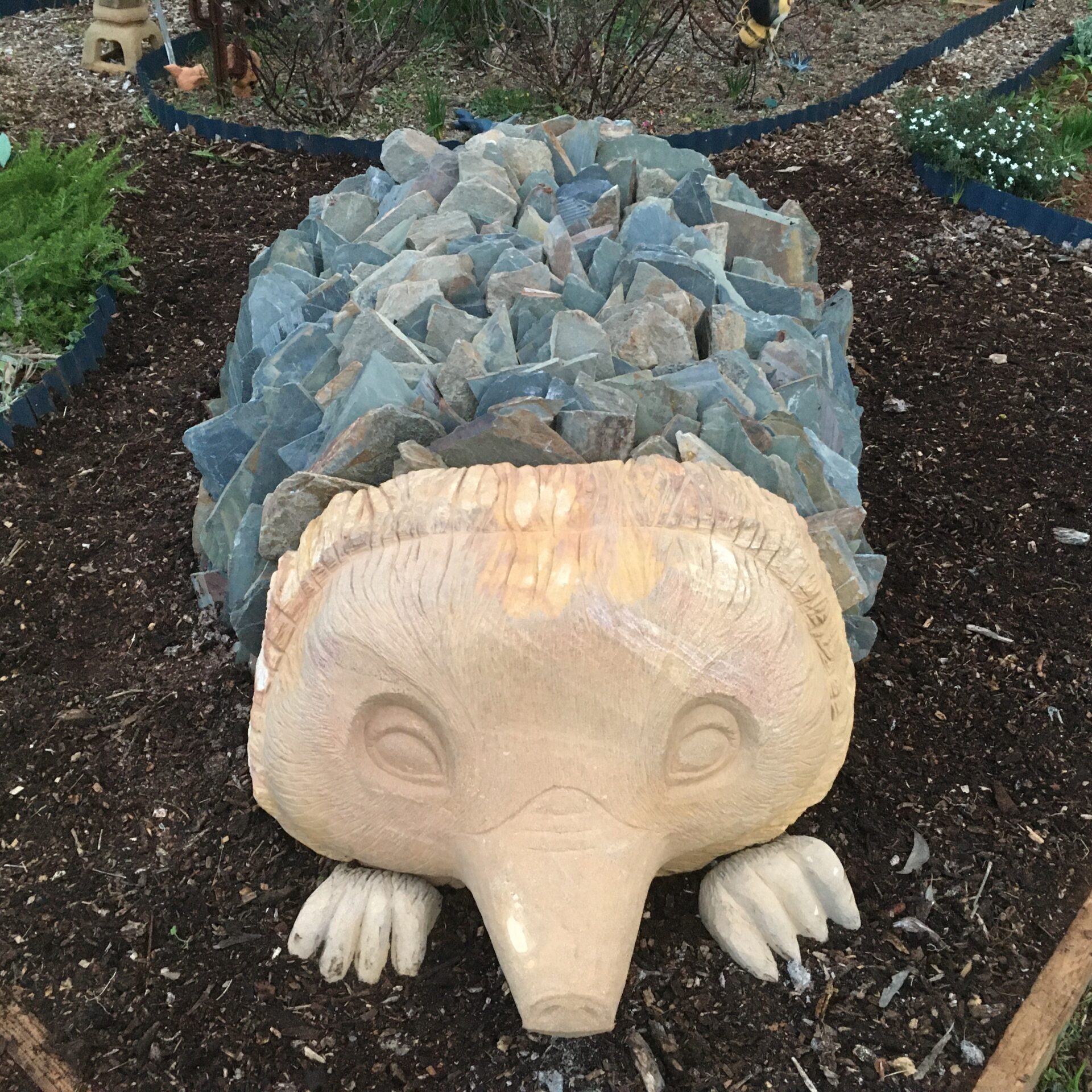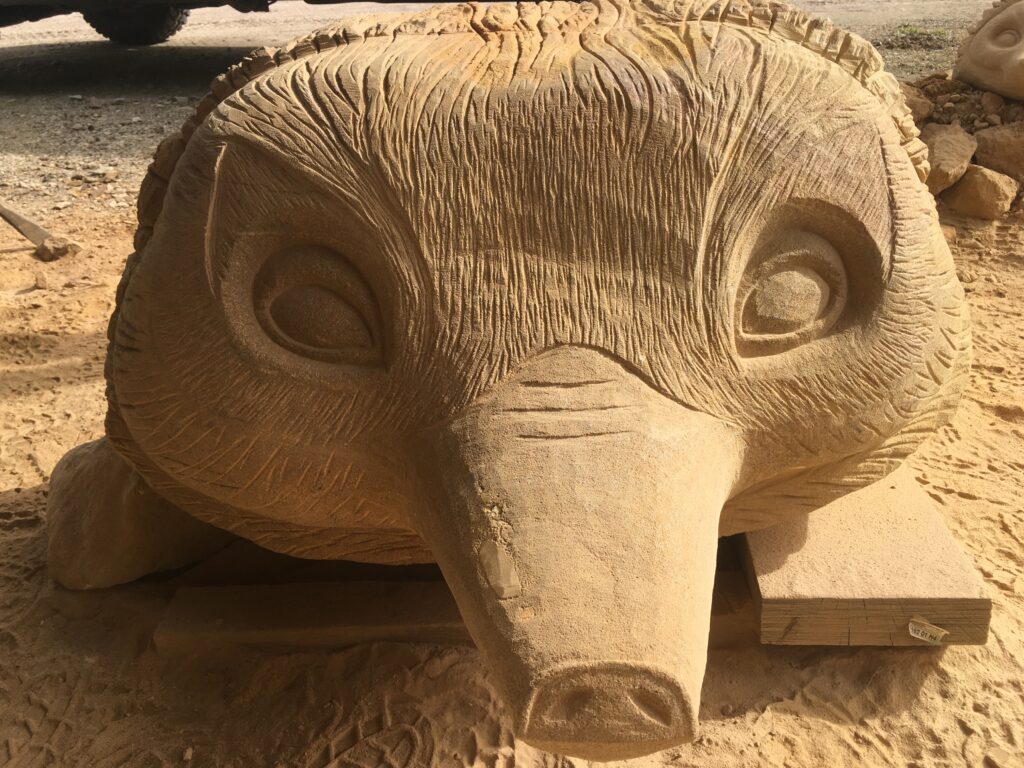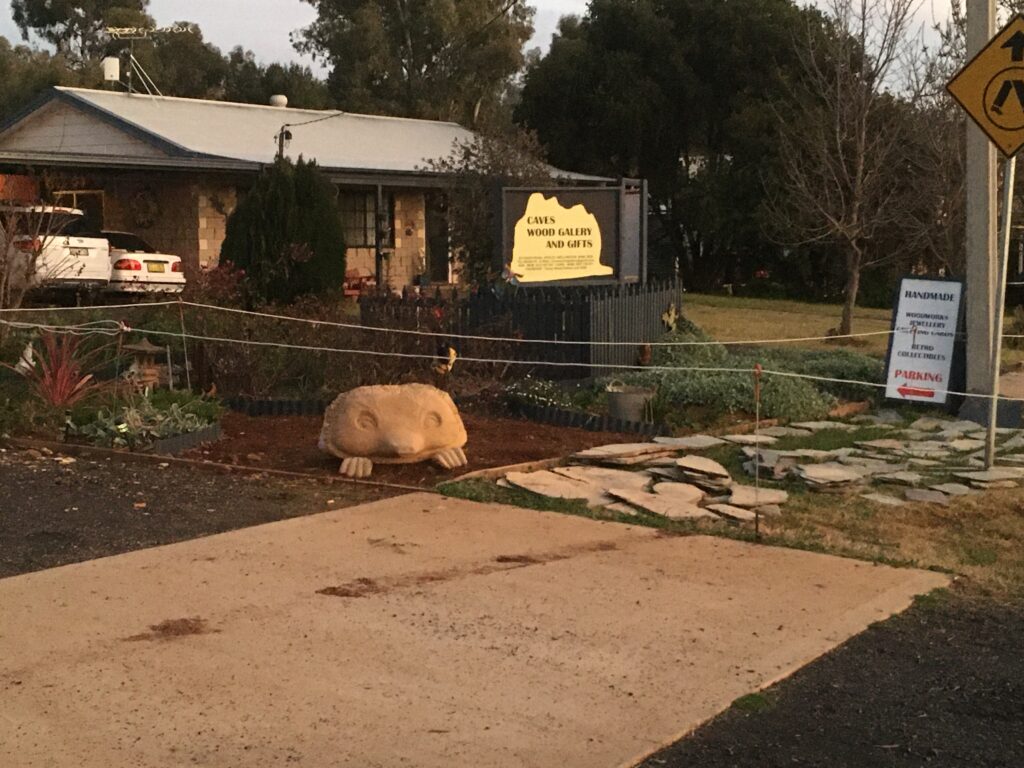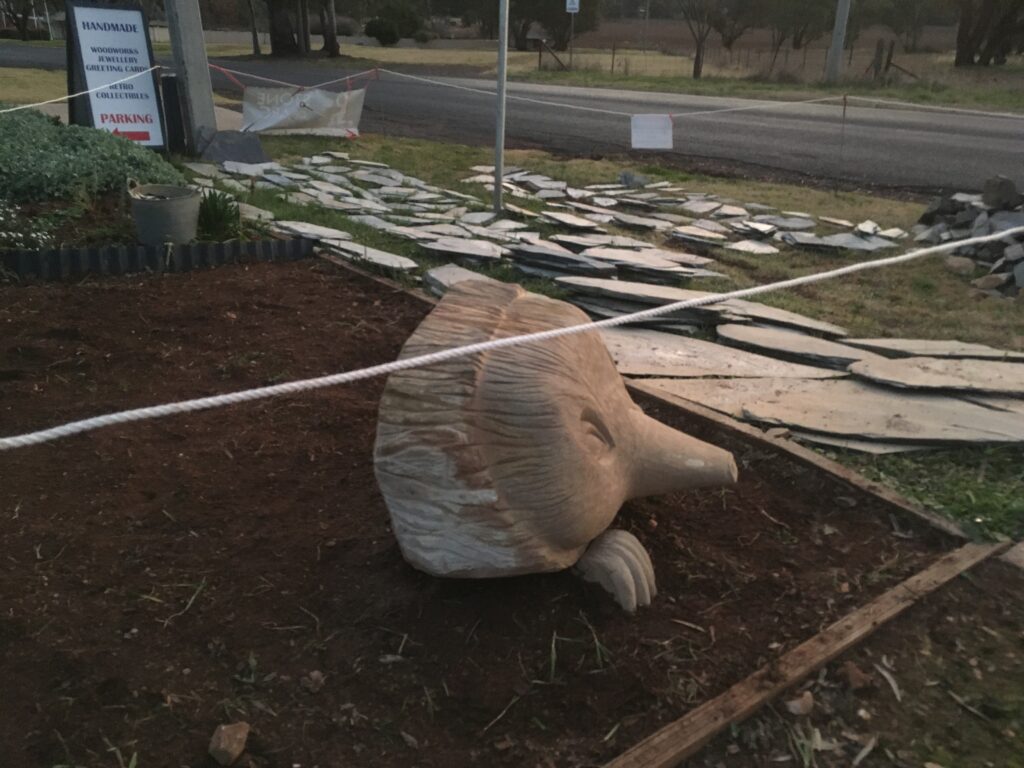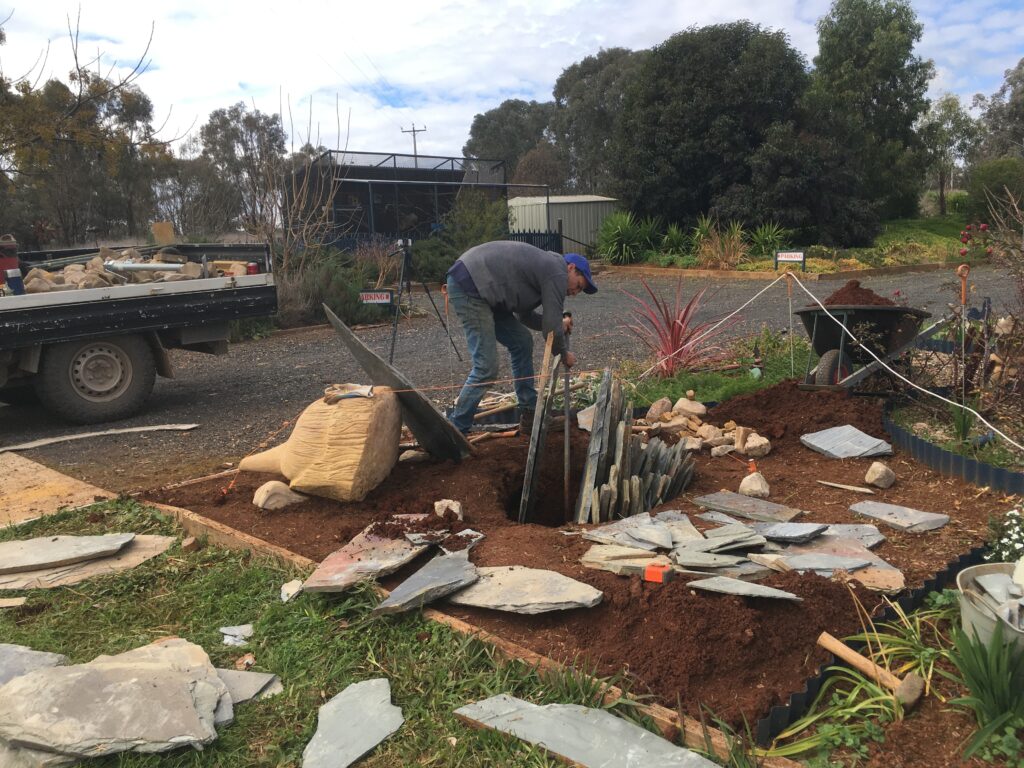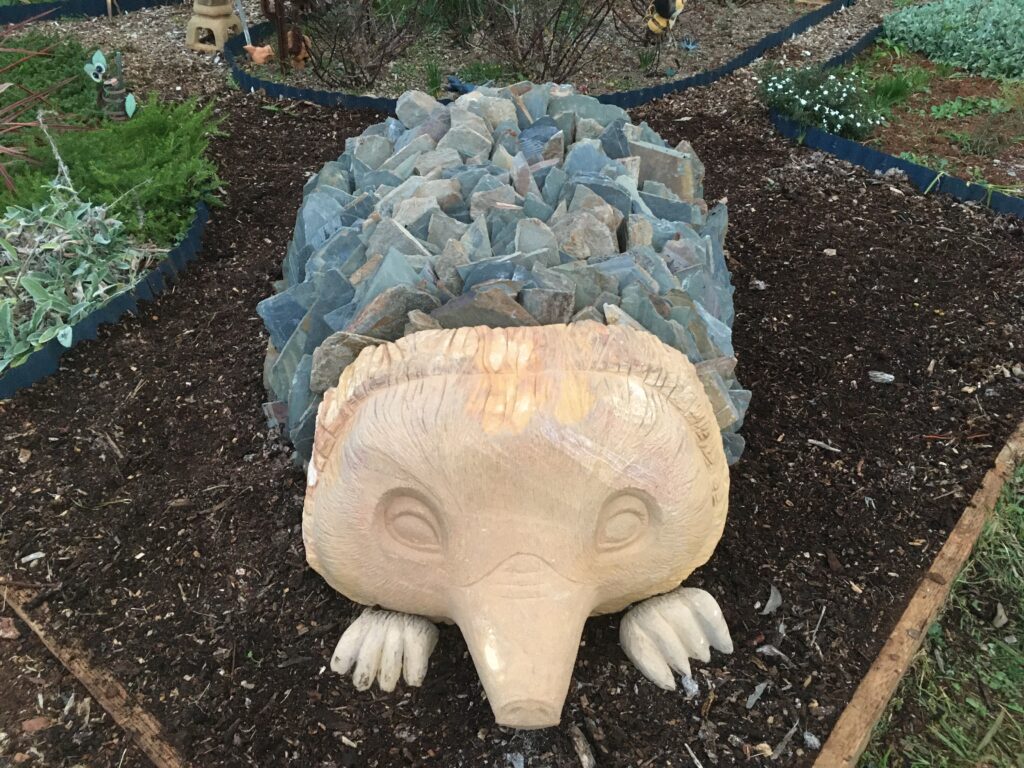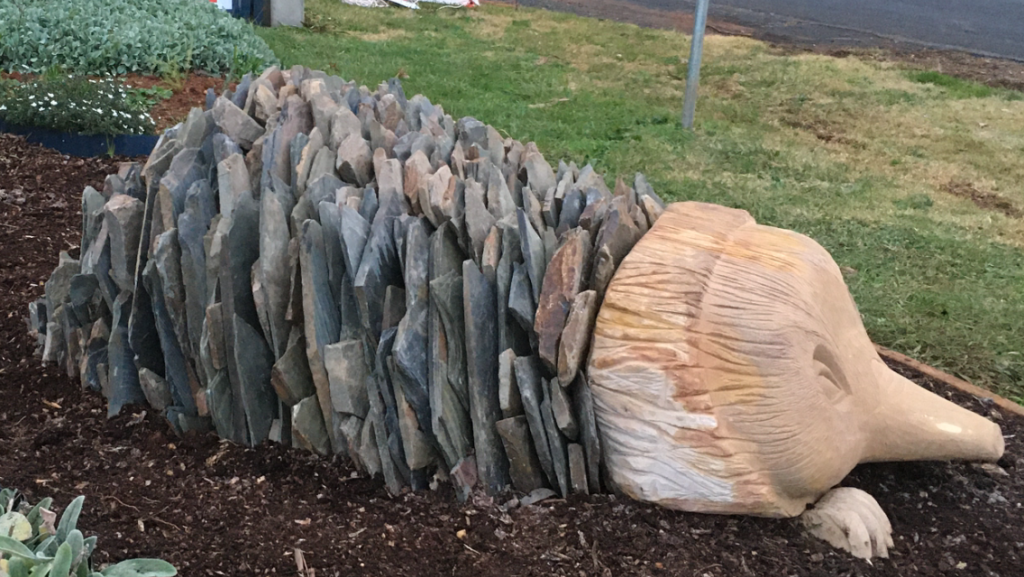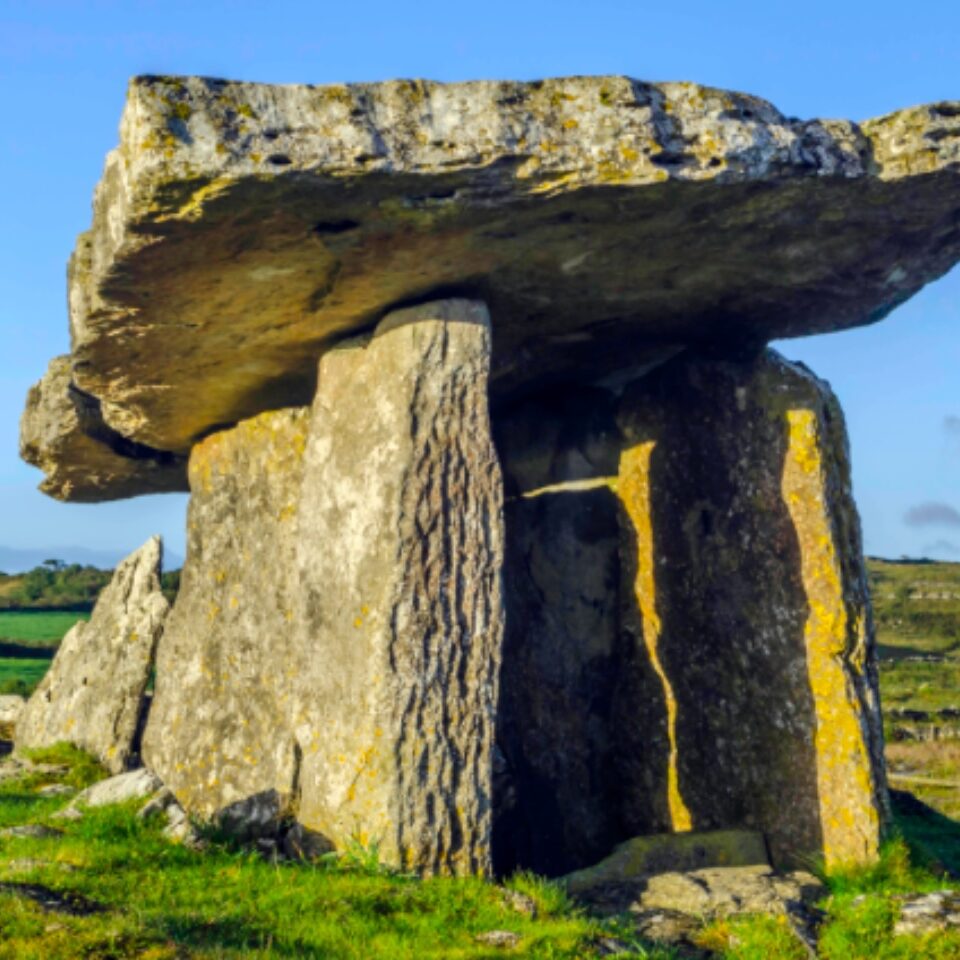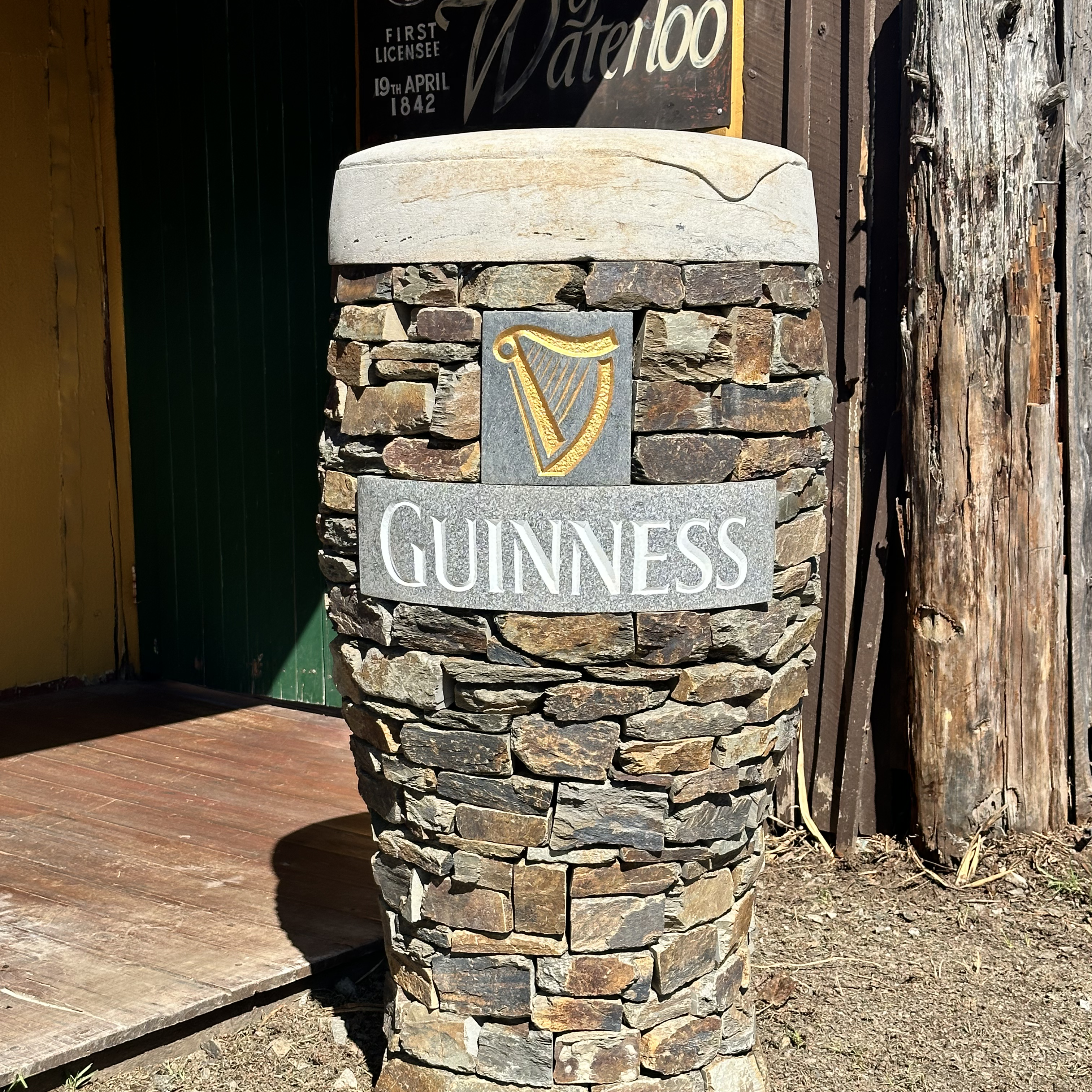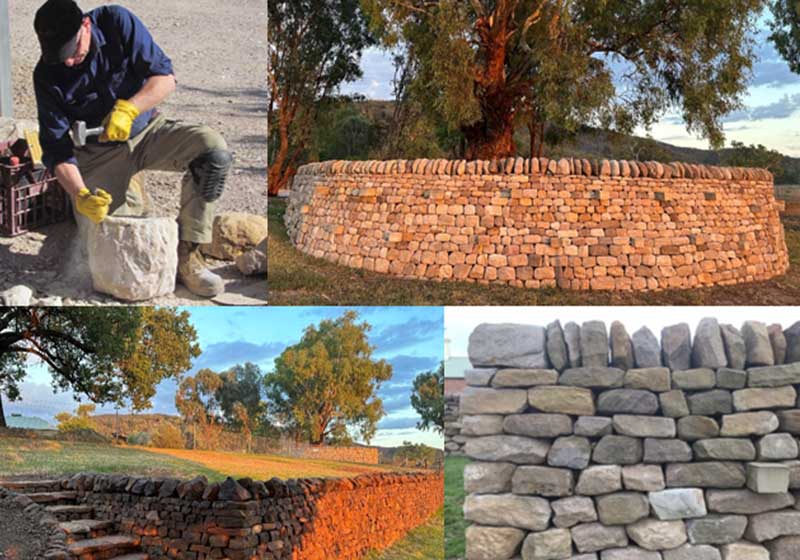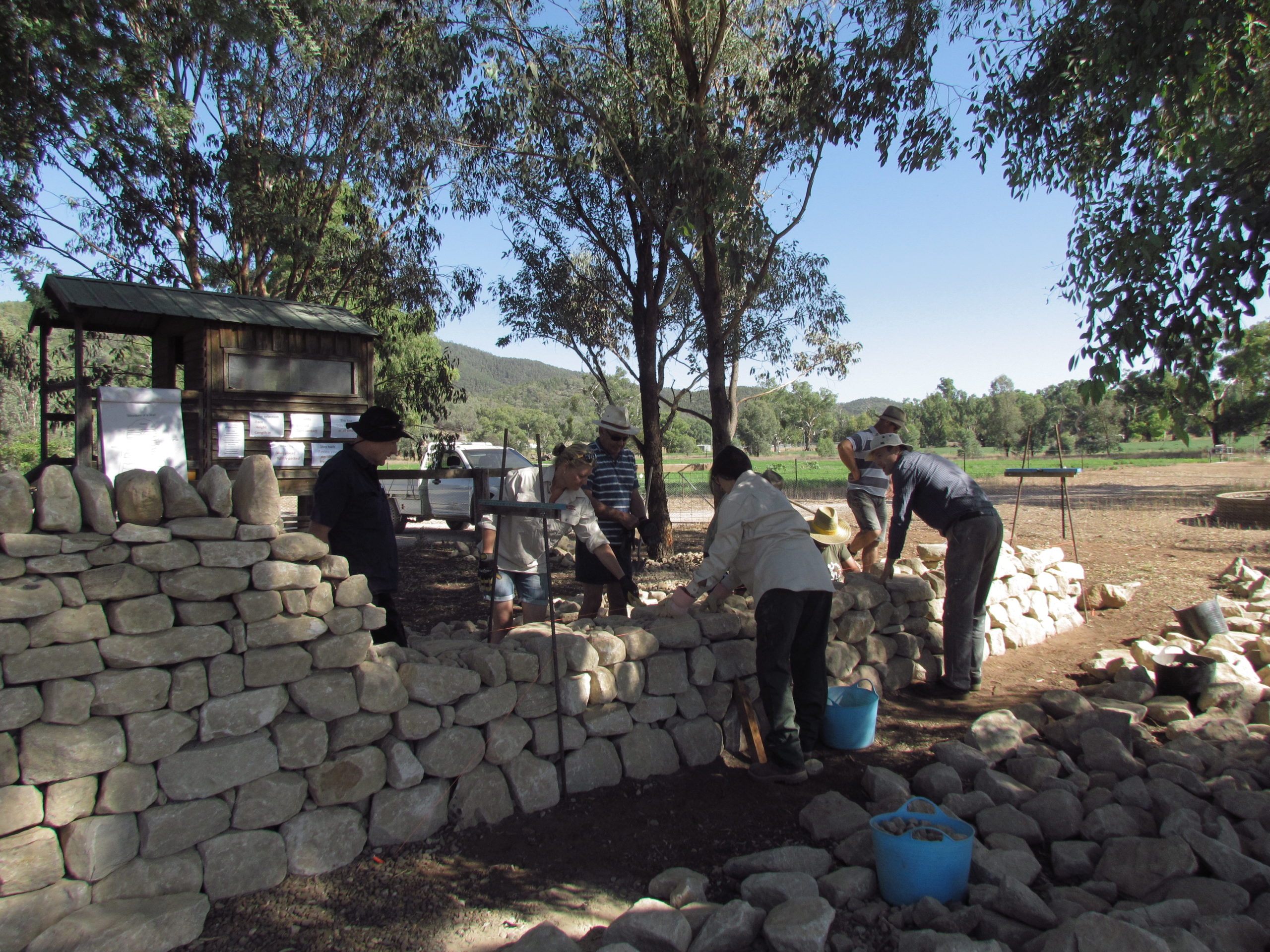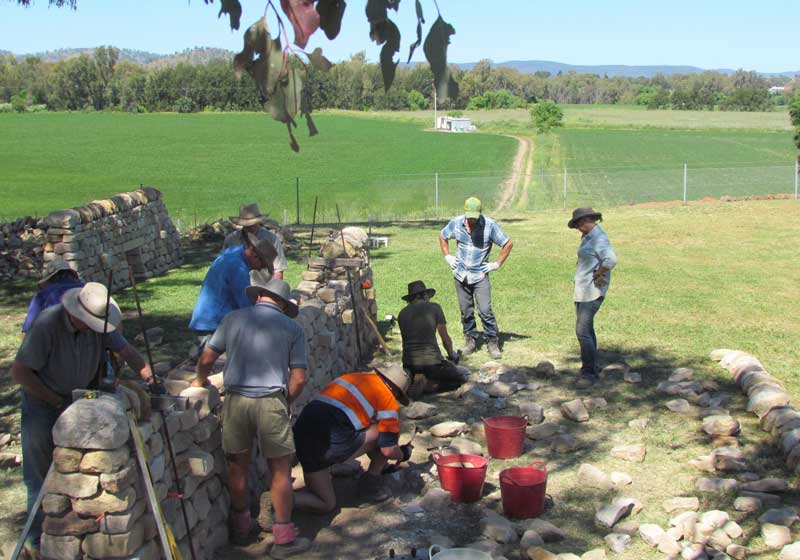The Dry Stone Trail
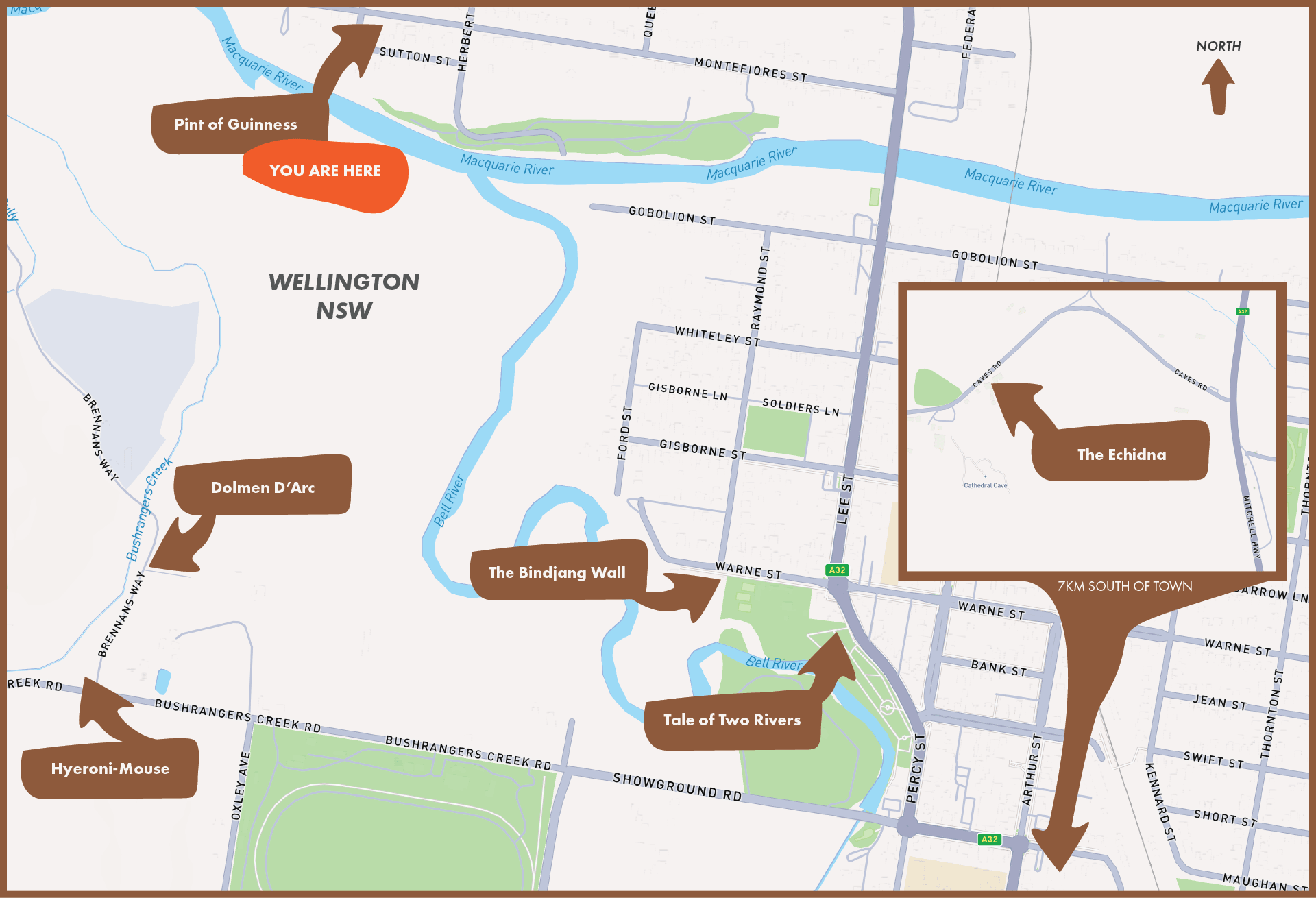
Part of the Dry Stone Way, a unique dry stone trail, comprising six impressive installations around the town of Wellington, NSW. Stone of Arc commenced construction of the trail in 2020, with the aim of highlighting local places and stories, through the ancient art of dry stone. Additional features were built over the ensuing years and the Dry Stone Way was officially opened in March 2025.
The Pint of Guinness
Constructed on St Patricks Day 2024, as part of the Great Australian Stone festival, to honour the fine stone festivals of Ireland. Built outside one of the oldest and best pubs in Australia, the Lion of Waterloo, the pint maintains the classic shape of the imperial pint, measuring 1.3m in height and incorporating approximately 300 stones placed around a central pole.
DESIGNED BY Jack McCallum and Geoff Duggan
CONSTRUCTED BY Jack McCallum (including letter cutting/carving) and Geoff and James Duggan, with assistance from the community!
MATERIALS USED Moruya slate (donated by Beashels Quarries); Granite Name/Logo (donated by Jim and Justin, Mulyandry); Sandstone (donated by Stone of Arc)


Part of the Dry Stone Way, a unique dry stone trail, comprising six impressive installations around the town of Wellington, NSW. Stone of Arc commenced construction of the trail in 2020, with the aim of highlighting local places and stories, through the ancient art of dry stone. Additional features were built over the ensuing years and the Dry Stone Way was officially opened in March 2025.
The Binjang (or Bindjang) Wall
Built during the Great Australian Stone Festival 2024 (GASF24). It is 12m long, 1.2m high incorporating 8 unique carvings depicting local Binjang narratives. The Brown snake, Wedge tailed eagle (Maliyan), and Echidna being local totems; the Hands illustrating the cultural initiation process; maps showing the parameters of the Wiradjuri nation and lands of the Binjang people; the Coolamon (or Guliman) being a multi-purpose tool; and the Pages of history regrettably representing the thriving pre-colonial and diminished post- colonial local Aboriginal culture. A time-capsule put together by Wellington High School was placed at the mid-point within the footings.
DESIGNED BY David Griffiths and a sub-committee of the
Wellington Aboriginal Action Panel representing the Binjang people of the Wiradjuri nation
CONSTRUCTED BY The GASF Community team with carvings by Ryan James, Simon Lumb and Jack McCallum
MATERIALS USED Merrygoen sandstone (donated by Central West Sandstone); Carving blocks (donated by Stone of Arc); delivered by Giffin Bulk Haulage
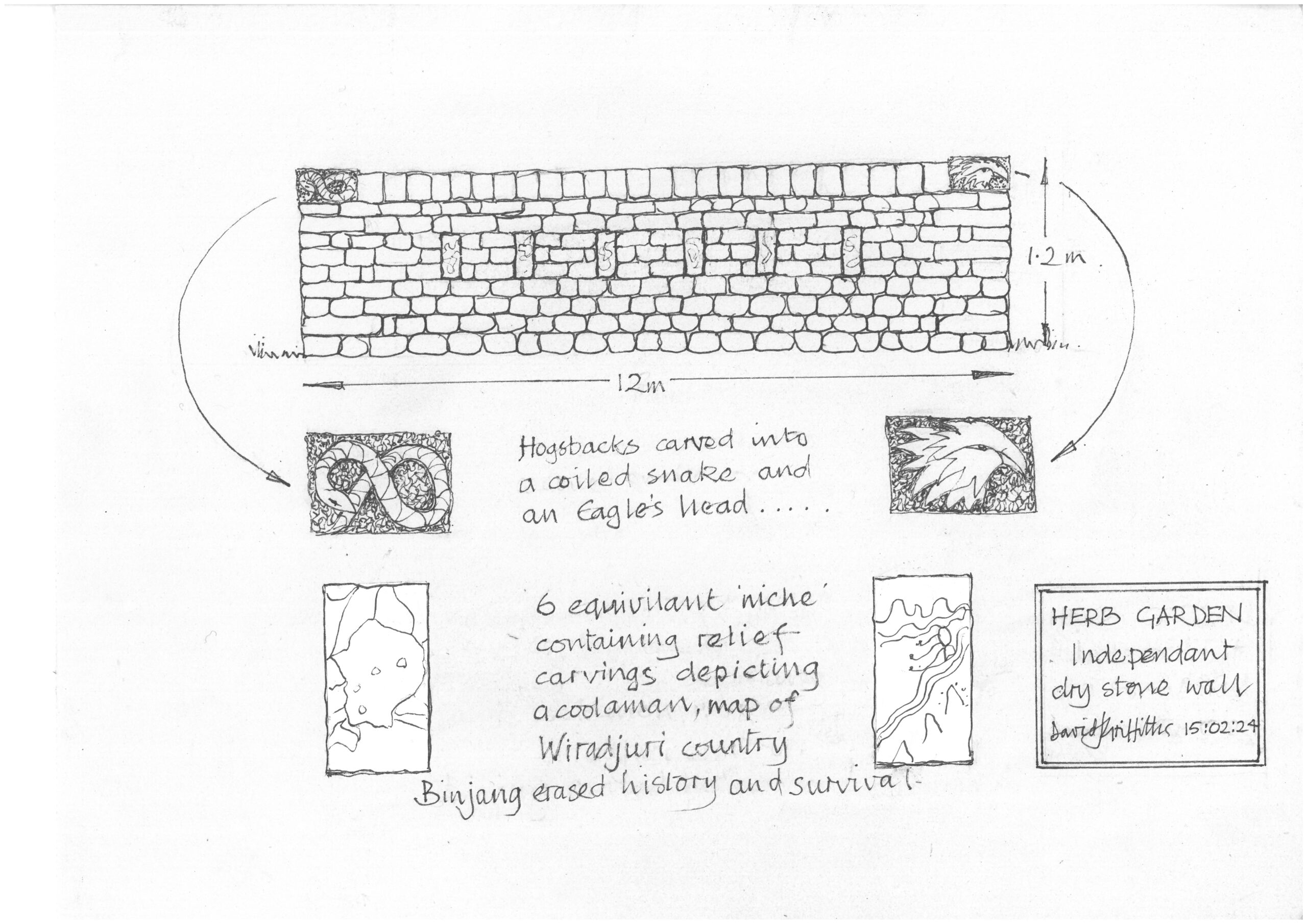

Part of the Dry Stone Way, a unique dry stone trail, comprising six impressive installations around the town of Wellington, NSW. Stone of Arc commenced construction of the trail in 2020, with the aim of highlighting local places and stories, through the ancient art of dry stone. Additional features were built over the ensuing years and the Dry Stone Way was officially opened in March 2025.
The Tale of Two Rivers
Built during the Great Australian Stone Festival 2024 (GASF24). It is around 30m in length, 1m high, incorporating 6 upright monoliths and four separate seating areas.
The 3 large monoliths in the centre represent the Mounts that overlook the town - Mount Duke, Arthur and Wellesley.
The two main walls flowing into each other represent the winding Wambuul (Macquarie) and Billibang (Bell) rivers and the point they meet beneath the mounts, under the Milky Way, a significant place in the Wiradjuri dreamtime story of Gadi, the rainbow serpent who travelled across country creating waterways.
Two of the seating areas are created in the shape of canoes, recognizing Aboriginal ingenuity and the old way of life beside the rivers, evidenced by the many canoe shaped scars visible in trees along the banks to this day. It is hoped that at some point in the future, the 3 book end monoliths can be carved into possum coats, to celebrate the wonderful cultural tradition of receiving a possum skin at birth, which is added to each year as the owner journeys through their life cycle.
A time-capsule put together by Wellington High School was placed at the base of the mountains.
DESIGNED BY David Griffiths and a sub-committee of the Wellington Aboriginal Action Panel representing the
Binjang people of the Wiradjuri nation
CONSTRUCTED BY The GASF24 advanced team, with carvings by Ryan James
MATERIALS USED Merrygoen sandstone (donated by Central West Sandstone); Carving blocks (donated by Dubbo Regional Council); delivered by Giffin Bulk Haulage
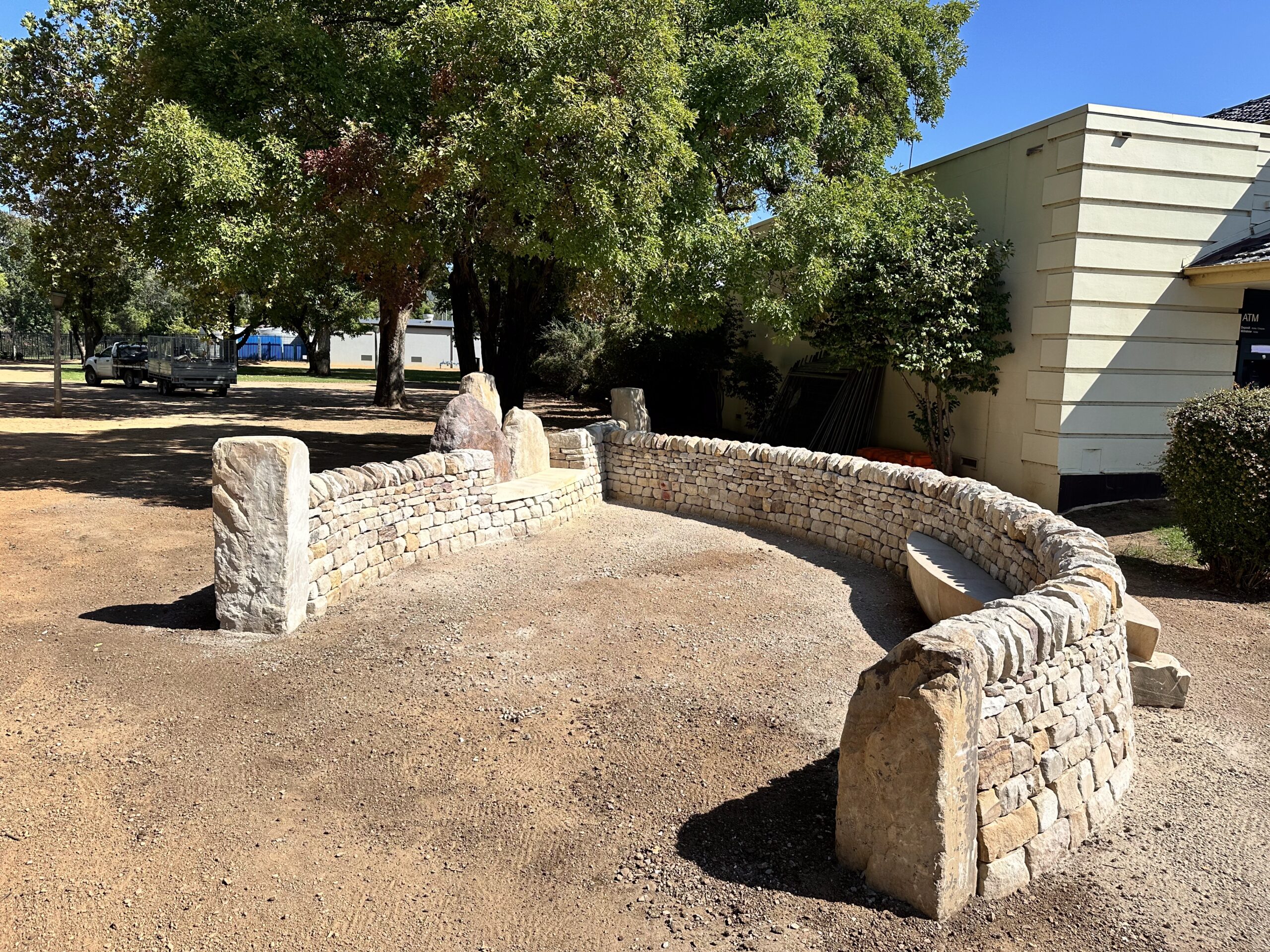
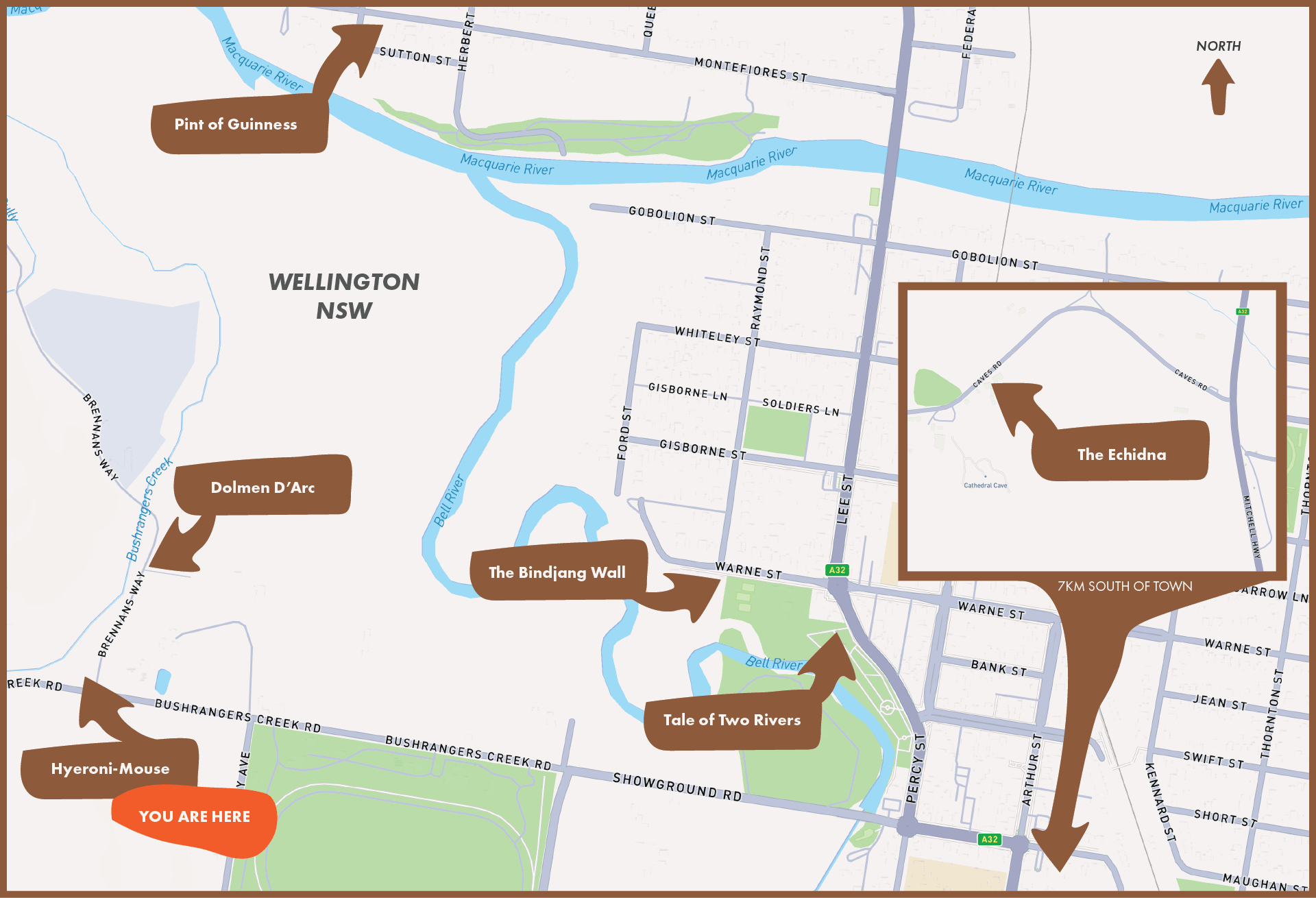
Part of the Dry Stone Way, a unique dry stone trail, comprising six impressive installations around the town of Wellington, NSW. Stone of Arc commenced construction of the trail in 2020, with the aim of highlighting local places and stories, through the ancient art of dry stone. Additional features were built over the ensuing years and the Dry Stone Way was officially opened in March 2025.
Hyeroni-Mouse
Built in 2021 to commemorate (and lighten the trauma of) the 18 month mouse plague of 2020-21, and also demonstrate that dry stone can be used to create all manner of things, not just walls. Hyeroni-Mouse helped start the conversation about what features could be built around Wellington as part of a dry stone trail, and it quickly became a popular attraction, regarded with great fondness by locals.
The mouse is 2.4m long with a 3m tail, and 70cm tall, all traditionally coursed incorporating a small contemplation seat at the rear. Amazingly, the original stick whiskers lasted until 2025 before replacement! From time to time, children extend the tail by placing additional stones.
This feature is named after Nicolas Hyeronimus, state Member for Wellington 1859-60, who built both the Lion of Waterloo public house (site of the Dry Stone Way’s Pint of Guinness) and the Glenrock homestead, where the Stone of Arc dry stone training centre is now situated.
DESIGNED BY David Griffiths and Emma Knowles
CONSTRUCTED BY Stone of Arc, in partnership with the Wellington Arts Centre Inc, with assistance from the community
MATERIALS USED Sydney sandstone (donated by Stone of Arc); local river stones
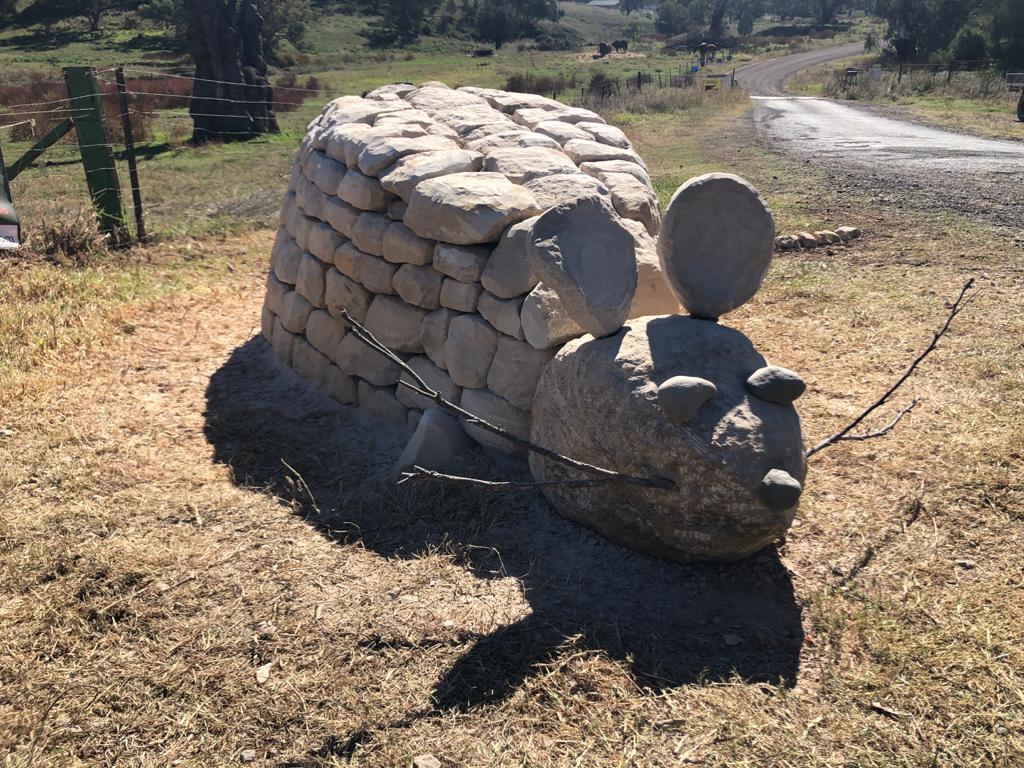
Construction Timelapse

Part of the Dry Stone Way, a unique dry stone trail, comprising six impressive installations around the town of Wellington, NSW. Stone of Arc commenced construction of the trail in 2020, with the aim of highlighting local places and stories, through the ancient art of dry stone. Additional features were built over the ensuing years and the Dry Stone Way was officially opened in March 2025.
The Dolmen d’Arc
The most recent addition to the Dry Stone Way, constructed in 2025. This feature is an ancient enduring structure, representing the timeless nature of human practices, inspired by other portal tombs built around the world to reflect the significance of the sunrise and the movement of the stars. Consisting of two or more upright stones supporting a large flat horizontal capstone, a dolmen’s entrance generally faces east. Dolmen d’Arc, however, faces west - towards Mount Arthur - in such a way that the setting sun reflected off the internal rear panel on March 29, 2025, the day the Stone of Arc Training Centre was officially completed. This dolmen comprises three sandstone uprights and a single limestone capstone.
The Dolmen d’Arc is a reminder of our shared heritage and the ways in which diverse cultures have sought to understand and celebrate the mysteries of existence, a connection to honour the past while looking forward to the future.
DESIGNED BY Emma Knowles
CONSTRUCTED BY Stone of Arc and Carl Giffin of Giffin Bulk Haulage
MATERIALS USED Merrygoen sandstone and limestone block (donated by Stone of Arc)
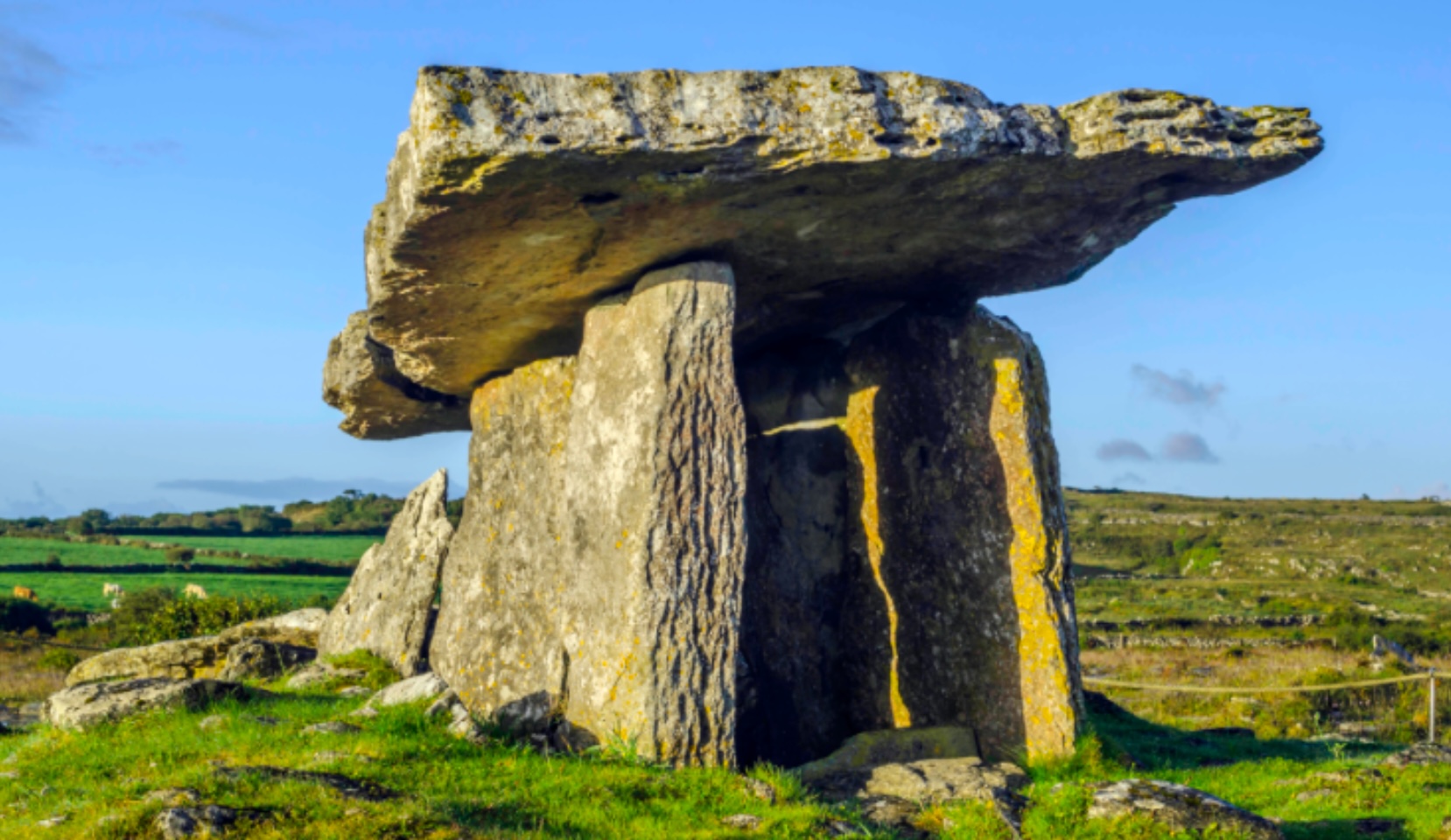
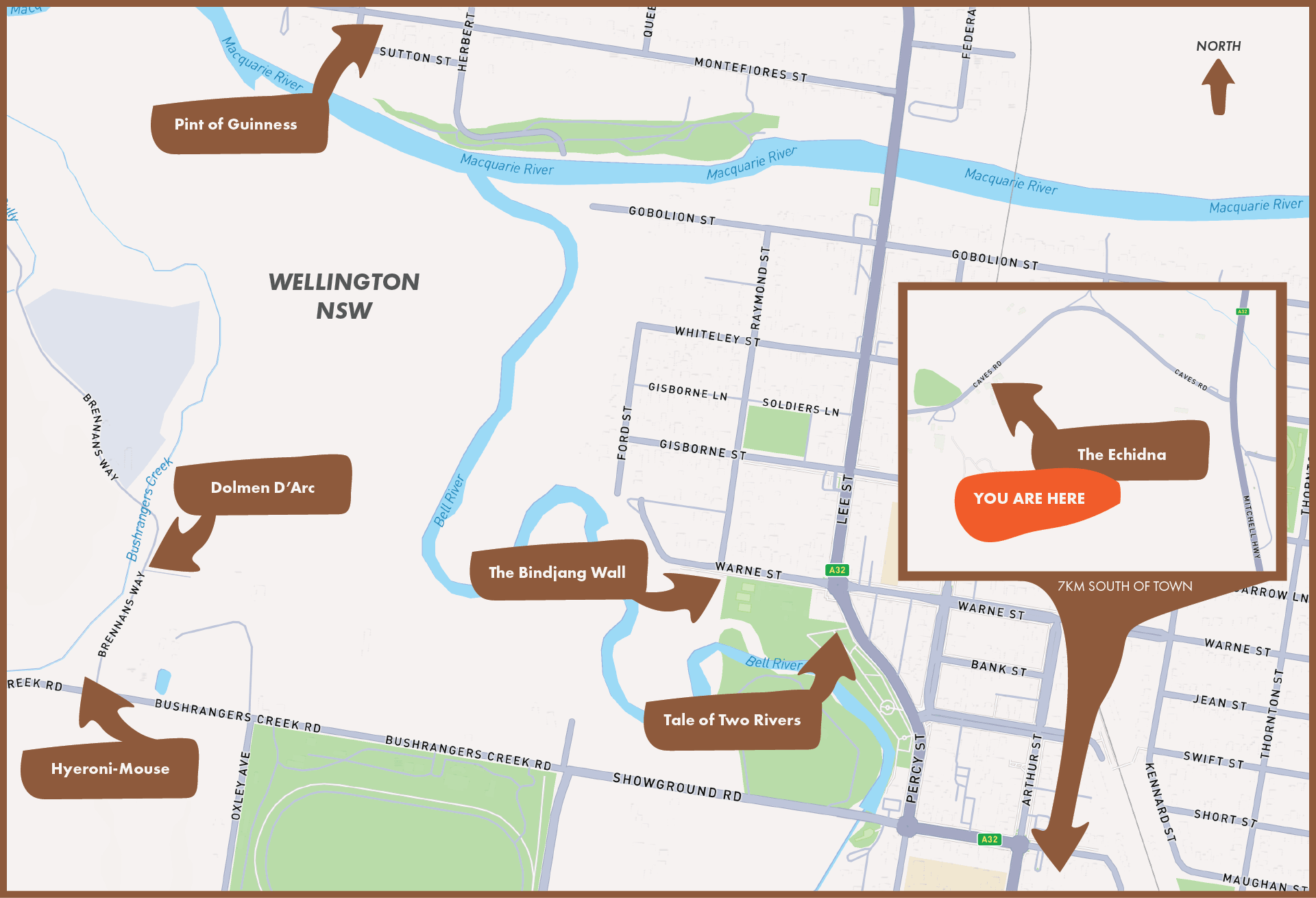
Part of the Dry Stone Way, a unique dry stone trail, comprising six impressive installations around the town of Wellington, NSW. Stone of Arc commenced construction of the trail in 2020, with the aim of highlighting local places and stories, through the ancient art of dry stone. Additional features were built over the ensuing years and the Dry Stone Way was officially opened in March 2025.
The Echidna
In Apsley, was built in 2022, commissioned by the owners of the Caves Wood Gallery who were keen to be part of the Dry Stone Way. The sandstone head is hand carved. The cut slate pieces are embedded into the ground one third their length. The structure is 70cm high, 80cm wide and 1.5m long.
DESIGNED BY Emma Knowles and David Griffiths
CONSTRUCTED BY Stone of Arc
MATERIALS USED Slate shards from Castlemaine, Vic; and Sydney sandstone

Construction Timelapse


